Qixiang Electron Science and Technology 5888UV VEHICLE RADIO User Manual
Qixiang Electron Science& Technology Co., Ltd VEHICLE RADIO
user manual
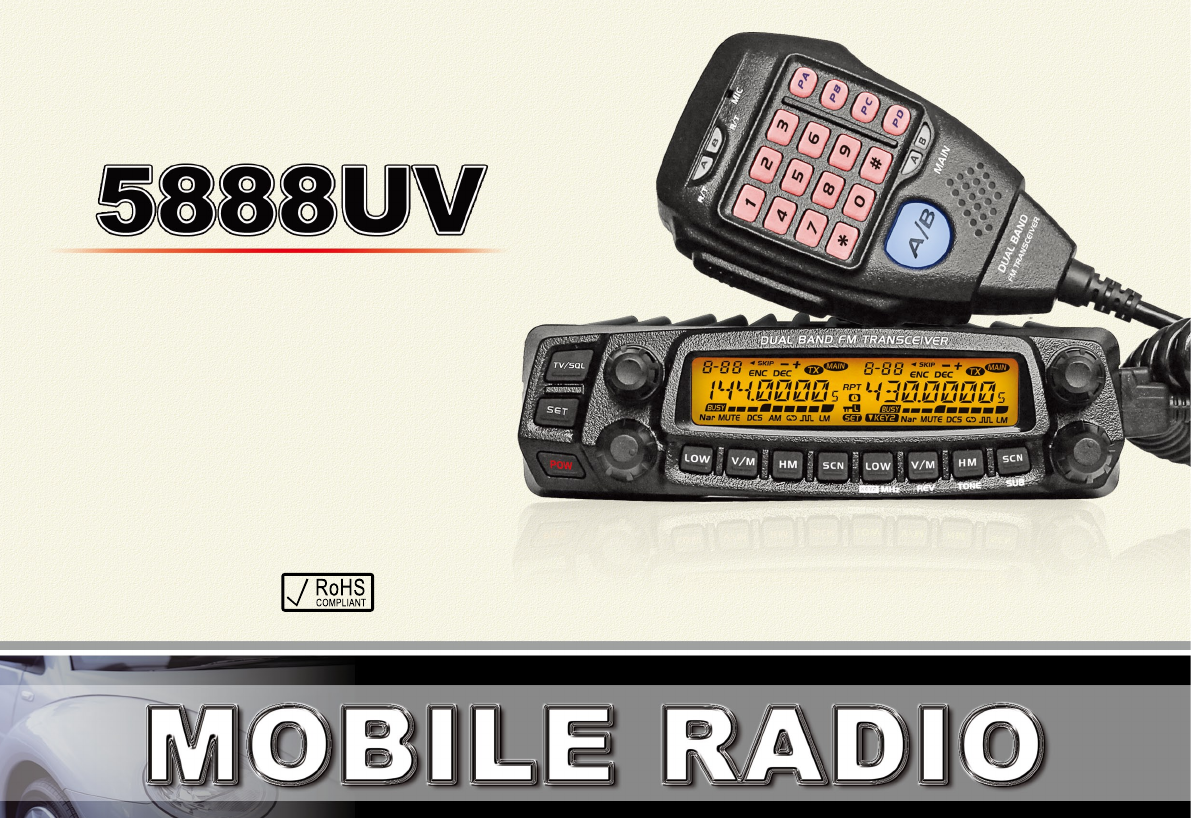
Dual Band
FM Transceiver
USER'S MANUAL
FCC ID:T4K-5888UV
Model:5888UV,5889UV,5888UV1,5888UV2,
5888UV3,5888UV4,5888UV5,5888UV6,
5888UV7, 5888UV8, 5888UV9,588UV,
DB-750X, HR-2040,DB-50M
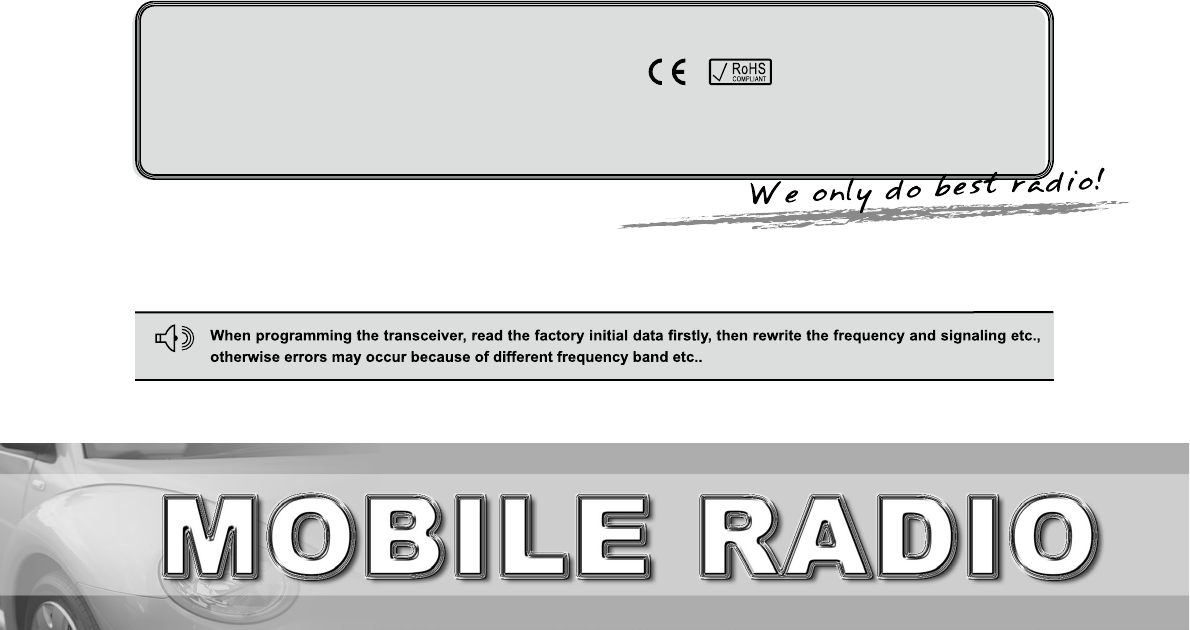
5888UV Mobile Radio Applicable Software: QPS5888UV Model Apply To This Manual: 5888UV Mobile radio
Nice Housing, Stoutness & Stability, Advanced and Reliable
functions, Perfect & Valuable. Approval. 5888UV
mobile radio especially designs for drivers and it pursues company
philosophy of innovation and practicality.
NOTE
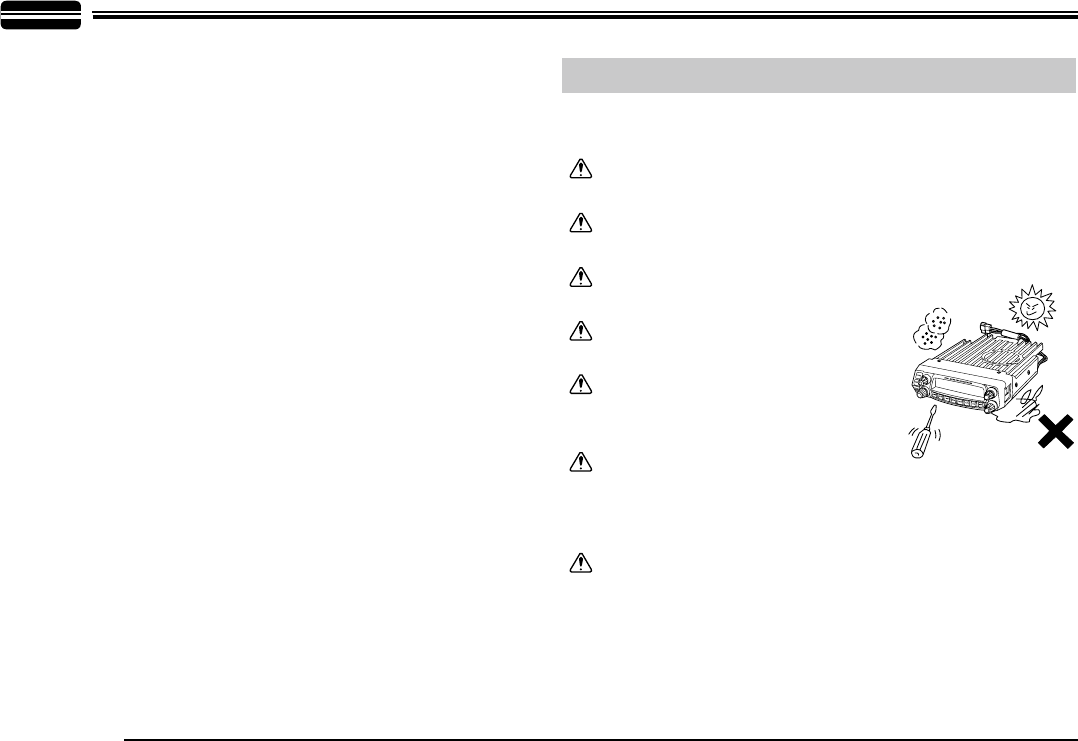
5888UV
Precautions
Thank you for choosing this mobile transceiver, which
always provide high quality products, and this transceiver is no
exception 5888UV is a ruggedly-built, high quality Dual Band
FM transceiver providing 50 Watts of power output on the VHF
band and 40 Watts on the UHF band. It owns many advanced
characters like cross band repeat function, built with a direct-ow
heat sink and thermostatically-controlled cooling fan maintaining
a safe temperature for the transceiver's circuit.
5888UV has four independent receiving bands, consist of
UU, UV,VU,VV for dual receive and dual output, plus receiving
for AM/FM signal of air band, marine band, PMR, etc.also able
to receive FM/TV radio and analogue TV signal. It owns 758
memory channels, full duplex operation with independent volume
and squelch controls, optional compander and builtin CTCSS/
DCS, DTMF, 5TONE,2TONE signaling, detachable front panel
for exible installation.
Though friendly design for user, this transceiver is technically
complicated and some features may be new to you. Consider
this manual to be a personal tutorial from the designers,allow the
manual to guide you through the learning process now, then act
as a reference in the coming years.
Please observe the following precautions to prevent fire,
personal injury, or transceiver damage:
Do not attempt to congure your transceiver while driving,it
is dangerous.
This transceiver is designed for a 13.8V DC power supply.
Don't use a 24V battery to power on the transceiver.
Do not place the transceiver in
excessively dusty, humid or wet
areas, nor unstable surfaces.
Please keep it away from
interferential devices (such as TV,
generator etc.)
Do not expose the transceiver to
long periods of direct sunlight nor
place it close to heating appliances.
If an abnormal odor or smoke is detected coming from the
transceiver, turn OFF the power immediately. Contact an
Anytone service station or your dealer.
Do not transmit with high output power for extended
periods; the transceiver may overheat.

CONTENTS
New and Innovative Features ...................................................1
Frequency Range ...................................................................1
Supplied Accessories/Optional Accessories ..........................2
Supplied Accessories ..............................................................2
Optional Accessories ..............................................................2
Initial Installation .......................................................................3
Mobile installation ...................................................................3
DC Power Cable Connection ..................................................4
Antenna Connection ...............................................................6
Accessories Connections ........................................................7
Getting Acquainted ...................................................................8
Front panel ..............................................................................8
Rear panel ..............................................................................9
DISPLAY .................................................................................9
microphone ...........................................................................10
Basic Operations .....................................................................11
Switching The Power On/Off .................................................11
Adjusting The Volume .......................................................... 11
Switch between VFO and Channel mode .............................11
Adjusting Frequency .............................................................11
Adjusting Channel .................................................................11
Switch Between Main Band and Sub band ...........................12
Selecting the frequency band ...............................................12
Receiving ..............................................................................12
Squelch Off/Squelch Off Momentary.....................................12
Transmitting ..........................................................................12
Shortcut Operations ................................................................13
Squelch level Setup ..............................................................13
Transmit DTMF/2TONE/5TONE signaling ............................13
High/Mid/Low Power Switch .................................................13
Frequency Reverse ...............................................................13
Band-width Selection ............................................................13
HOME Channel .....................................................................13
Super channel select ............................................................13
Dual Watch............................................................................14
Emergency Alarm ..................................................................14
Channel/Frequency Scan .....................................................14
Channel Scan Skip ...............................................................14
Channel Edit .........................................................................14
Scan range Limit ..................................................................14
Channel Copy .......................................................................14
Channel Delete .....................................................................15
General Setting ........................................................................16
APO (Automatic Power off) ...................................................16
Automatic offset ....................................................................16
Frequency Channel Step Setup ............................................16
VFO Band lockout .................................................................17
Beep Function .......................................................................17
CPU Clock frequency Change ..............................................17
2TONE Encode select ..........................................................17
5TONE Encode select ..........................................................18
Add Optional signaling ..........................................................18
CTCSS encode Setup ..........................................................18
CTCSS decode Setup ...........................................................19
Sub Band Display Setup .......................................................19
DTMF Encode Pre-Loading time ..........................................19
DTMF Encode Transmitting Time .........................................20
DTMF Encode setup .............................................................20

5888UV
Squelch Mode Setup .............................................................20
Compander ...........................................................................21
Scrambler Setup ...................................................................21
Tone Bust (Pilot Frequency) ..................................................21
Keypad Mode Setup .............................................................22
Keypad Lockout ....................................................................23
TX OFF (PTT Lockout) .........................................................23
Squelch Level setup ..............................................................23
TALK AROUND .....................................................................23
Sub band mute setup ............................................................24
Editing Channel Name ..........................................................24
Channel Function Auto storeage Setup ................................24
Microphone PA,PB, PC,PD key setup ..................................25
RF Squelch level setup .........................................................25
OFFSET Direction setup .......................................................25
Scan Dwell Time Setup .........................................................25
Priority channel scan .............................................................26
Offset frequency Setup .........................................................26
Display mode Setup ..............................................................26
Busy Channel Lockout ..........................................................27
Radio's DTMF SELF ID ENQUIRY .......................................27
5TONE SELF ID ENQUIR ....................................................27
TOT (Time-out timer) ............................................................27
VFO Frequency Linkage .......................................................28
Wide/Narrow band ................................................................28
Cross Band repeat ................................................................28
LCD backlight ........................................................................28
Keypad backlight brightness .................................................29
Calling Record ......................................................................29
AM Function ..........................................................................29
Automatic AM function ..........................................................29
VHF External speaker port ....................................................30
BEEP Volume control ..........................................................30
Password Function ...............................................................30
Microphone Operation ............................................................31
Send DTMF signaling ...........................................................31
Main/Sub band switching ......................................................31
Function operation through PA-PD keys ...............................31
Cable Clone ..............................................................................33
RESUME FACTORY DEFAULT ............................................33
Programming Software Installing and Starting (in windows
XP system) ...............................................................................34
Install USB Cable Driver Programme ...................................34
Maintenance .............................................................................35
Trouble Shooting ...................................................................35
Specications ..........................................................................36
Attached Chart .........................................................................37
51 groups CTCSS Tone Frequency(Hz) ...............................37
1024 groups DCS Code ........................................................37
CONTENTS
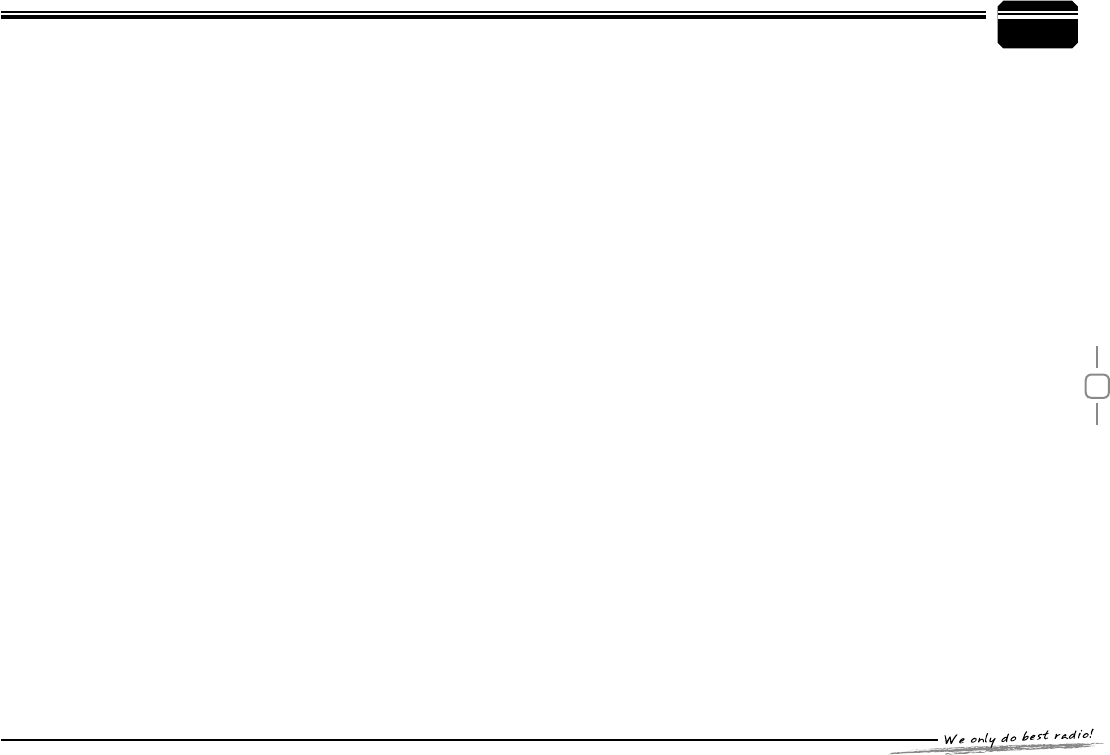
1
1
5888UV Mobile Radio has nice housing, stoutness & stability, advanced and reliable functions, perfect & valuable. This amateur mobile radio
especially designs for drivers and it pursues company philosophy of innovation and practicality. More functions as follows:
758 memory channels, full duplex operation with independent volume and squelch controls
50 Watts of power output on the VHF band and 40 Watts on the UHF band with cross band repeater function.
Four independent receiving bands, consist of UU, UV,VU,VV for dual receive and dual output, plus receiving for AM/FM signal of air band,marine
band, PMR, etc; able to receive FM/TV radio and analogue TV signal.
Display on a large LCD with adjustable brightness, convenient for nighttime use. There are Amateur operation mode and Professional operation
mode for option.
Distribute buttons reasonably, convenient for operation. Adopt superior quality material, better technology and direct-ow heat sink to ensure
stable and durable operation.
758 programmable memory channels, identied by editing name.
Programming different CTCSS, DCS, 2Tone, 5Tone in per channel, rejecting extra calling from other radios.
Various scan functions including CTCSS/DCS Scan function.
Using 5Tone to send Message, Emergency alarm, Call all, ANI, Remotely kill, Remotely Waken, etc.
Automatic calling ldentication function by DTMF--ANI or 5Tone--ANI .
Multi groups of x scrambling and 2 groups of self dene scrambling.
Compander function for decrease the background noise and enhance audio clarity, it can set compander ON/OFF per channel.
12.5K for narrow band.
Theft alarm provides extra safety.
Frequency Range
136~174MHz and 400~520 MHz
New and Innovative Features
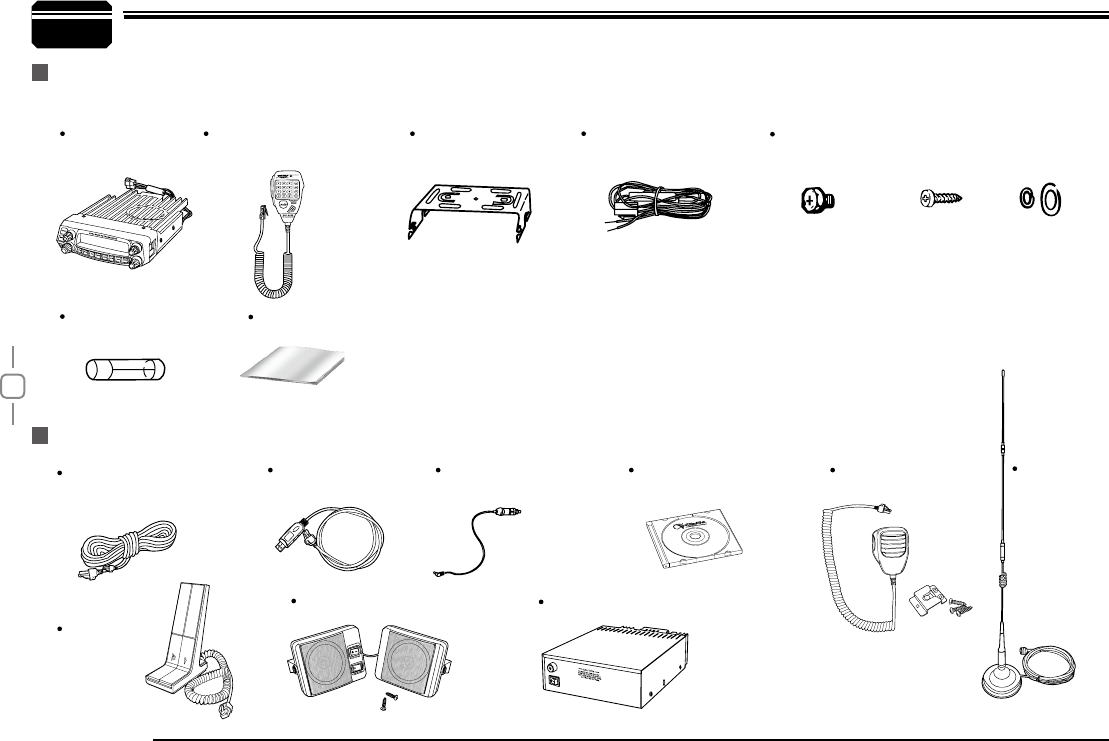
2
5888UV
2Supplied Accessories/Optional Accessories
SUPPLIED ACCESSORIES
OPTIONAL ACCESSORIES
After carefully unpacking the transceiver, identify the items listed in the table below. We suggest you keep the box and packaging.
Transceiver
Spare Fuses
(QF-01)
User Manual
3 meter extending cable
for attachable panel/
Cloning Cable(CP52)
Programming Software
(QPS-5888UV)
Car Antenna
(QCA-02)
Mobile Mounting
Bracket (QMB-01)
DC Power Cable with
Fuse Holder(QPL-01)
Microphone (QHM-04)
(with DTMF keyboard)
Microphone
(QHM-02)
S-Washer
(QSS-01D)
Hardware Kit for Bracket
Black screws
(M4X8mm)
4PS(QSS-01A)
Tapping screws
(M5X8mm)
4PS(QSS-01B)
USB Programming
Cable (PC51)
Cigar-Plug Connection
Line (QCC-01)
Desktop
Microphone
(QDM-01)
Power supply (QRP-01)
External Speaker (SP-02)
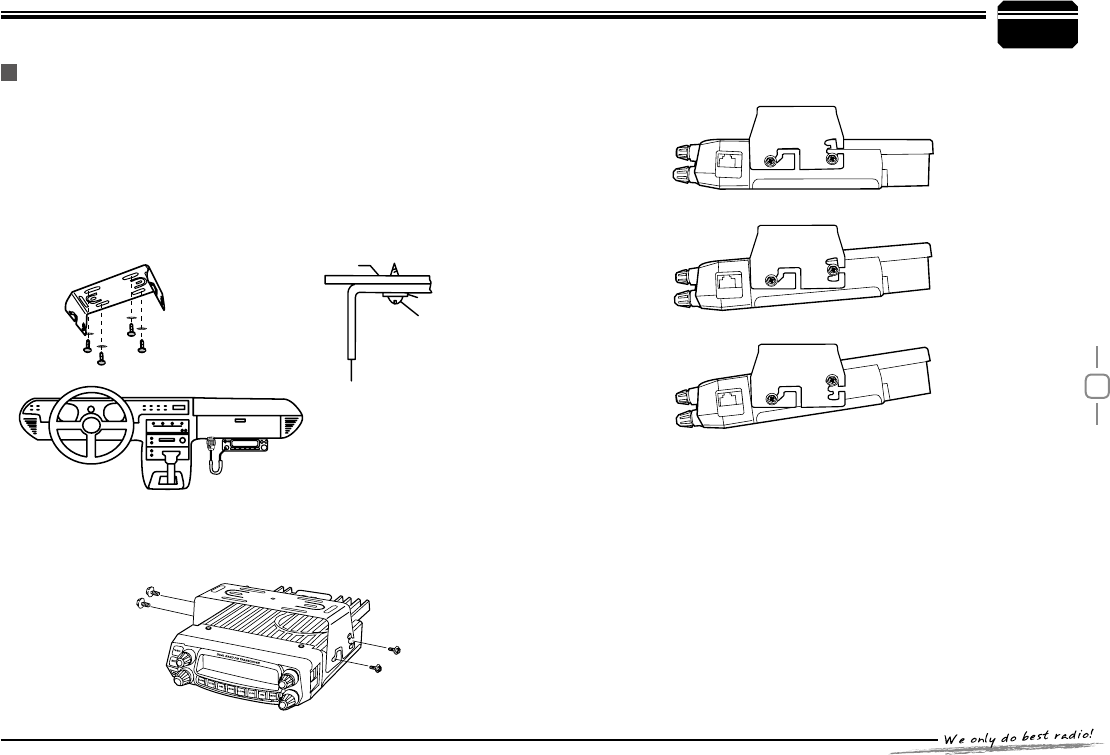
3
3
MOBILE INSTALLATION
To install the transceiver, select a safe, convenient location inside your
vehicle that minimizes danger to your passengers and yourself while the
vehicle is in motion. Consider installing the unit at an appropriate position
so that knees or legs will not strike it during sudden braking of your
vehicle. Try to pick a well ventilated location that is shielded from direct
sunlight.
Install the mounting bracket in the vehicle using the supplied self-
1.
tapping screws (4pcs) and at washers (4pcs).
Position the transceiver, then insert and tighten the supplied hexagon
2.
SEMS screws.
Car body
Mounting bracket
Washer (M5)
Tapping screw
(M5X20mm)
Double check that all screws are tightened to prevent
vehiclevibration from loosening the bracket or transceiver.
Initial Installation
Determine the appropriate angle of the transceiver, using the 3
screw hole positions on the side of the mounting bracket.
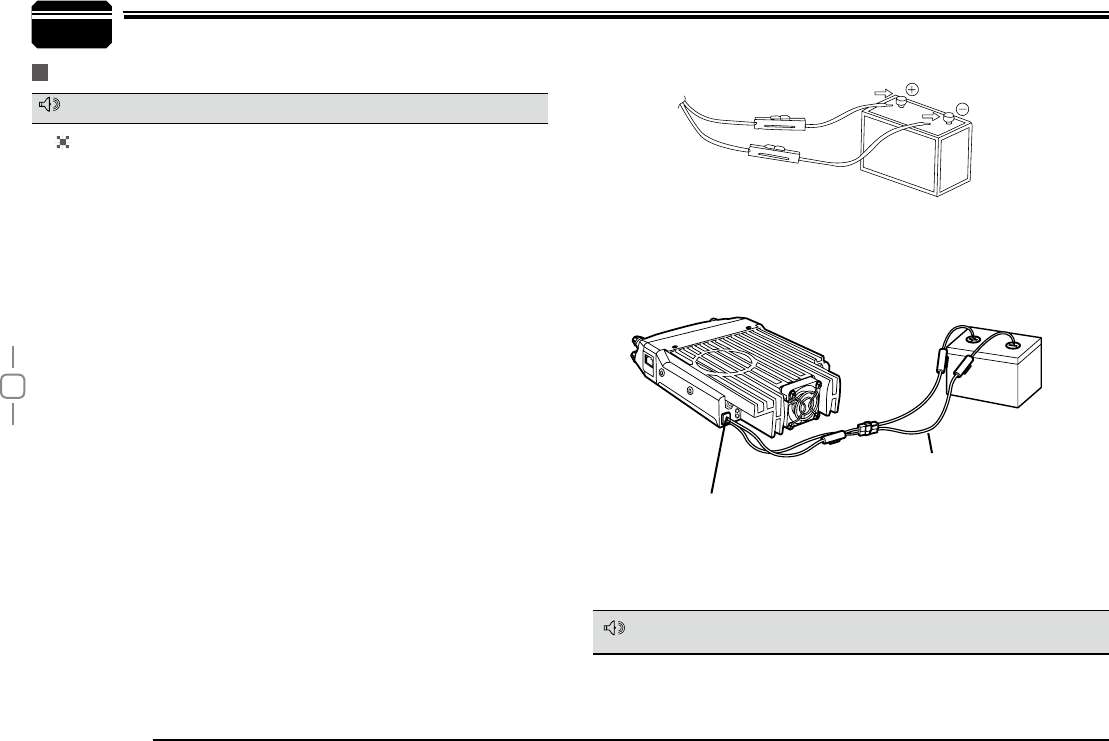
4
5888UV
3Initial Installation
DC POWER CABLE CONNECTION
Locate the power input connector as close to the transceiver as possible.
MOBILE OPERATION
The vehicle battery must have a nominal rating of 12V. Never
connect the transceiver to a 24V battery. Be sure to use a 12V
vehicle battery that has sufficient current capacity. If the current
to the transceiver is insufficient, the display may darken during
transmission, or transmitting output power may drop excessively.
Route the DC power cable supplied with the transceiver directly
1.
to the vehicle's battery terminals using the shortest path from the
transceiver.
We recommend you do not use the cigarette lighter socket
as some cigarette lighter sockets introduce an unacceptable
voltage drop.
The entire length of the cable must be dressed so it is isolated
from heat, moisture, and the engine secondary (high voltage)
ignition system/ cables.
After installing cable, in order to avoid the risk of damp, please
2.
use heat-resistant tap to tie together with fuse box. Don't forget
to reinforce whole cable.
In order to avoid the risk of short circuit, please cut down
3.
connection with negative (-) of battery, then connect with radio.
Conrm the correct polarity of the connections, then attach the
4.
power cable to the battery terminals; red connects to the positive
(+) terminal and black connects to the negative (-) terminal.
Use the full length of the cable without cutting off excess even
if the cable is longer than required. In particular, never remove
the fuse holders from the cable.
Reconnect any wiring removed from the negative terminal.
5.
Connect the DC power cable to the transceiver's power
6.
supplyconnector.
Press the connectors rmly together until the locking tab clicks.
If the ignition-key on/off feature is desired(optional feature),use the
Red
Black
optional QCC-01(For Cigar-Plug connection) cable. Connect one
of the cables between the ACC terminal or a Cigar-Plug that operates
with the vehicle ignition or ACC switch on the vehicle and EXT
POWER jack on the rear side of the unit.
Ext. Power jack
DC power cable
In many cars,the cigar-lighter plug is always powered. If this is the case,
you cannot use it for the ignition key on/off function.
NOTE
NOTE
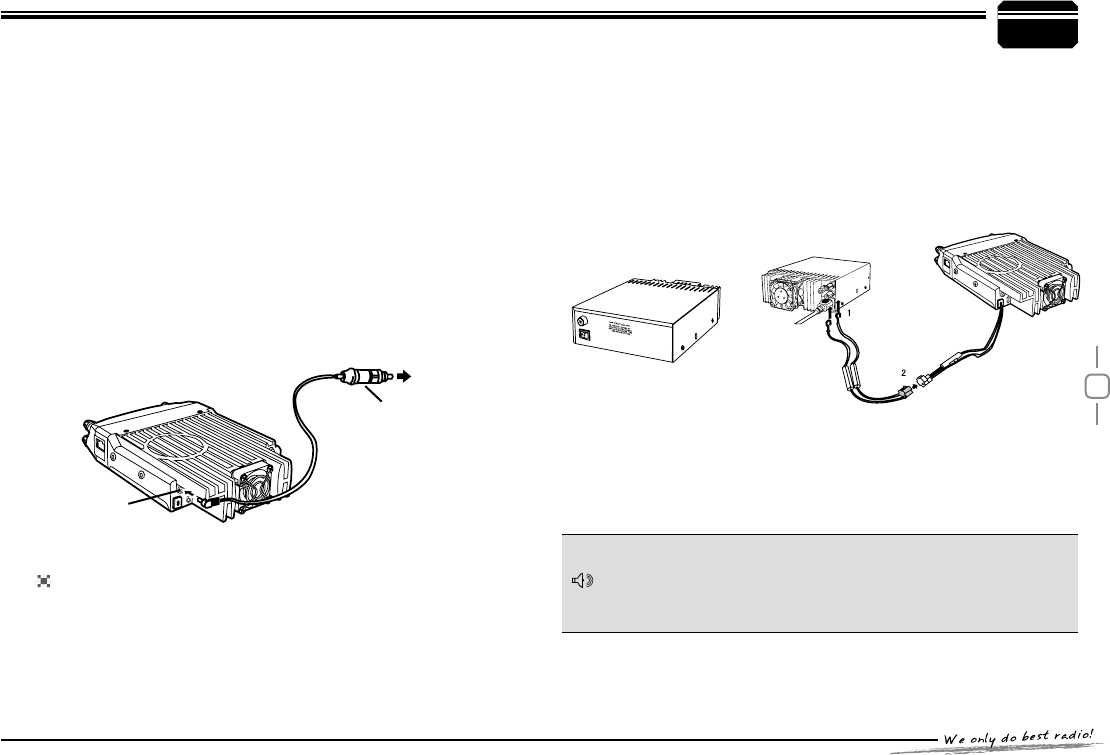
5
When the ignition key is turned to ACC or ON(Start) position
7.
with the radio turned off, the power switch illuminates. The
illumination will be turned off when the ignition key is turned
to the off position.To turn on the unit, press the power switch
manually while it is illuminated. (While ignition key is at ACC or
ON position)
3
Initial Installation
When the ignition key is turned to ACC or ON position with the
8.
radio's power switch on, the unit turns on automatically and the
power switch will be lit. Turn the ignition key to OFF position or
manually turn the power switch off to shut down the radio.
Using extra cable,power consumption:5MAH.
9.
Without this function,user can turn on/off radio by Power knob.
10.
Ext. Power jack
Cigar-Plug connection
ACC terminal
Do not directly connect the transceiver to an AC outlet.
Use the supplied DC power cable to connect the transceiver
to a regulated power supply.
Do not substitute a cable with smaller gauge wires.
FIXED STATION OPERATION
In order to use this transceiver for fixed station operation, you
will need a separate 13.8V DC power supply (not included) , power
supply( QRP-01) as optional accessories. Please contact local
dealer to require.
The recommended current capacity of your power supply is 12A.
Before connecting the DC power to the transceiver, be sure to
switch the transceiver and the DC power supply OFF.
Do not plug the DC power supply into an AC outlet until you
make all connections.
Regulated power supply (QRP-01)
DC power cable with fuse holder (QPL-01)
Black
Red
Regulated
power supply
(QRP-01)
Connect the DC power cable to the regulated DC power supply
1.
and ensure that the polarities are correct. (Red: positive,
Black:negative).
Connect the transceiver's DC power connector to the
2.
connector on the DC power cable.
Press the connectors rmly together until the locking tab
clicks.
NOTE
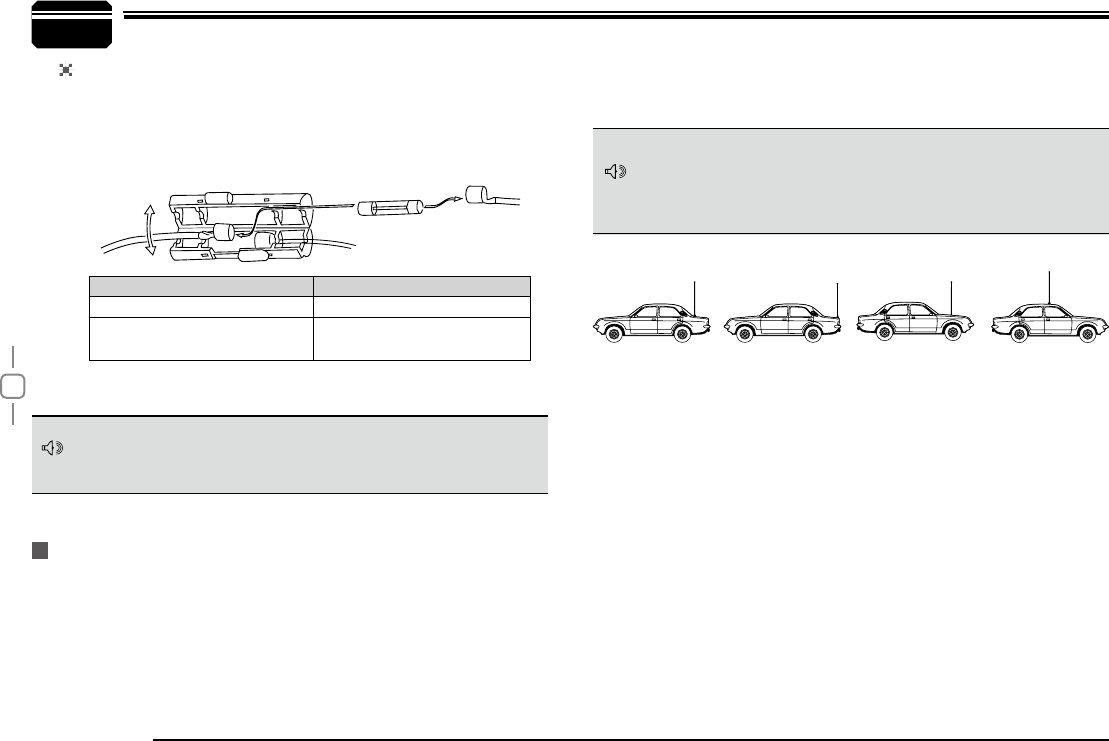
6
5888UV
If the fuse blows, determine the cause, then correct the problem.
After the problem is resolved, replace the fuse. If newly installed
fuses continue to blow, disconnect the power cable and contact your
authorized dealer or an authorized servicecenter for assistance.
Only use fuses of the specified type and rating, otherwise the
transceiver could be damaged.
Before operating, install an efcient, well-tuned antenna. The success
of your installation will depend largely on the type of antenna and its
correct installation. The transceiver can give excellent results if the
antenna system and its installation are given careful attention.
Use a 50Ω impedance antenna and low-loss coaxial feed-line that
has a characteristic impedance of 50 Ω, to match the transceiver input
impedance. Coupling the antenna to the transceiver via feed-lines having
The possible locations of antenna on a car are shown as following:
3Initial Installation
REPLACING FUSES
If you use the transceiver for a long period when the vehicle battery is
not fully charged, or when the engine is OFF, the battery may become
discharged, and will not have sufcient reserves to start the vehicle. Avoid
using the transceiver in these conditions.
Transmitting without first connecting an antenna or other
matched load may damage the transceiver. Always connect
the antenna to the transceiver before transmitting.
All xed stations should be equipped with a lightning arrester to
reduce the risk of re, electric shock, and transceiver damage.
Fuse Location Fuse Current Rating
Transceiver 15A
Supplied Accessory DC
power cable 20A
ANTENNA CONNECTION
an impedance other than 50Ω reduces the efficiency of the antenna
system and can cause interference to nearby broadcast television
receivers, radio receivers, and other electronic equipment.
NOTE
NOTE
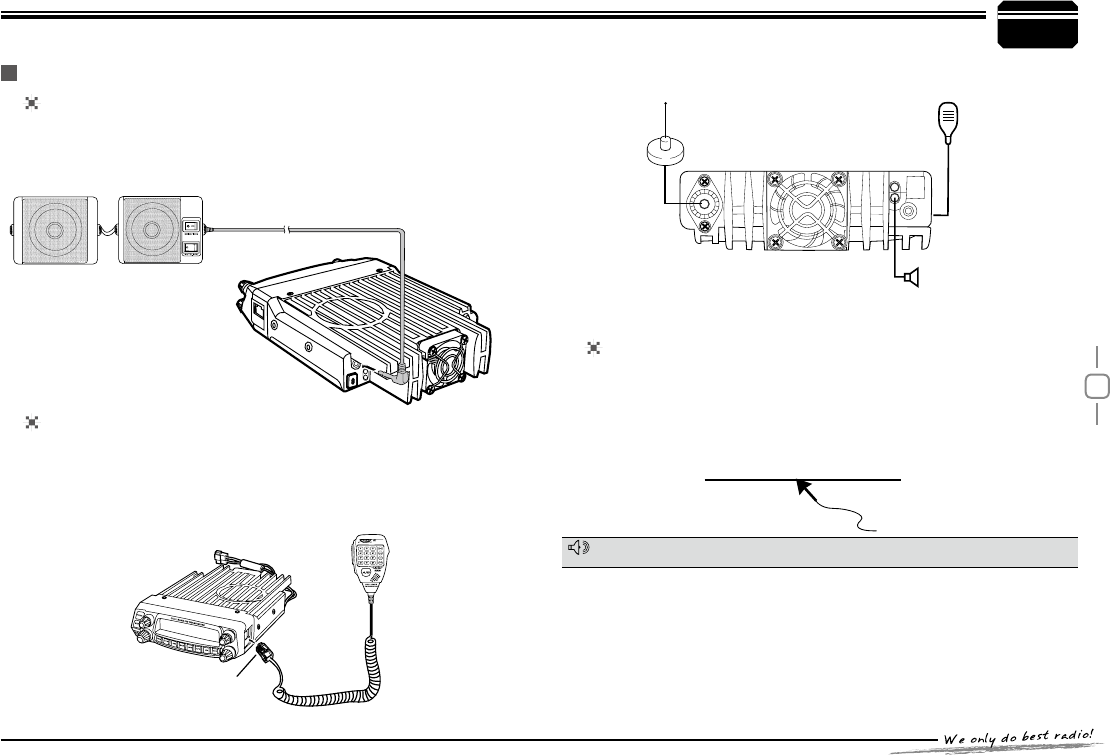
7
3
If you plan to use an external speaker, choose a speaker with an
impedance of 8 Ω. The external speaker jack accepts a 3.5 mm (1/8")
mono (2-conductor) plug.
For voice communications, connect a microphone equipped with
an 8-pin modular plug into the modular socket on the front of the
main unit. Press rmly on the plug until the locking tab clicks. Attach
the supplied microphone hanger in an appropriate location using the
screws included in the screw set.
To untilize the QPS5888UV software, you must first connect the
transceiver to your PC then using an optional programming cable
PC50 (via Data socket ).
Please use QPS-5888UV software for programming.
Initial Installation
EXTERNAL SPEAKER
MICROPHONE
PC CONNECTING
Ask your dealer about purchasing a Programming Cable PC51.
ACCESSORIES CONNECTIONS
SP-02
http://www.qxdz.cn
External speaker[SP-02]
Microphone[QHM-04]
Antenna[QCA-02]
NOTE
Microphone
connector
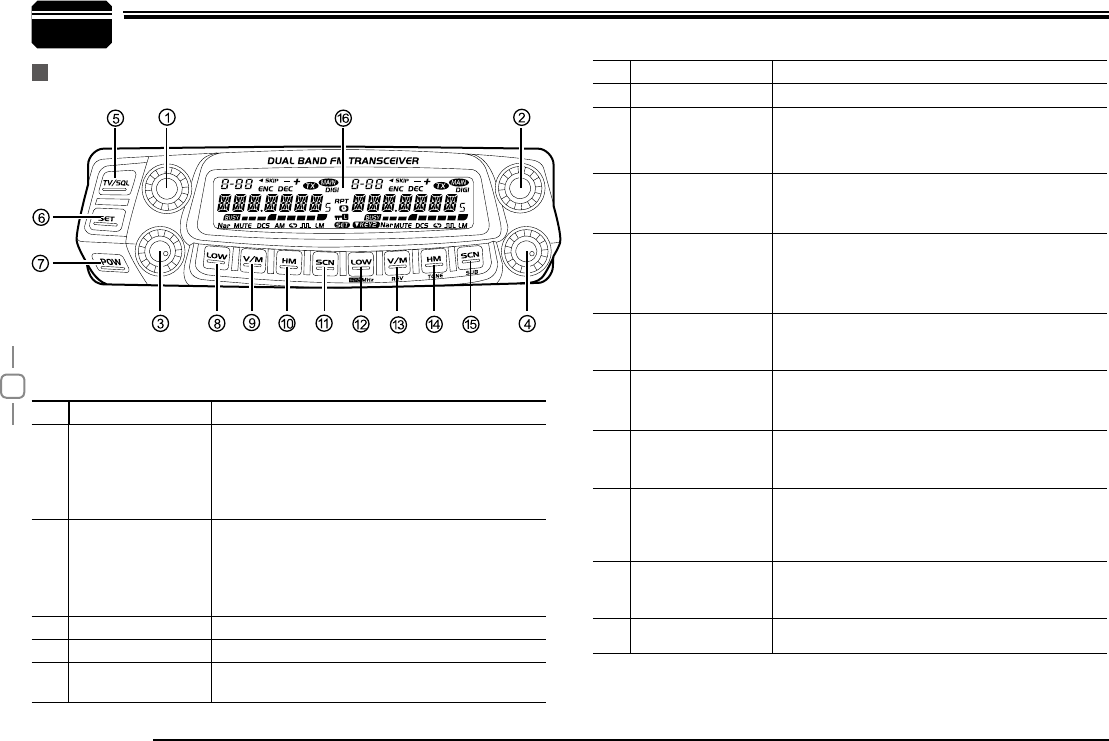
8
5888UV
4
Basic Functions•
NO. KEY FUNCTION
1 Left Dial Knob
Rotate it to choose frequency /channel. Press
it to set the left band as "Main Band"; In VFO
mode, press it to choose the frequency band;
In function setup as conrm key; in scan mode,
rotate it to change scan direction
2 Right Dial Knob
Rotate it to choose frequency /channel. Press
it to set the right band as "Main Band"; In VFO
mode, press it to choose the frequency band;
In function setup as conrm key; in scan mode,
rotate it to change scan direction
3 Left Volume Knob Adjust left band voluem level.
4 Right Volume Knob Adjust right band voluem level.
5
【
TV/SQL
】
In standby. press this key to turn On/Off TV
function.Hold this key to cancel squelch
Getting Acquainted
FRONT PANEL
6 Function set Key In standby , press this key to enter function menu
7 Power Press it to power On /Off the transceiver
8 Left
【
LOW
】
Key
In standby press to change H/L power for present
channel.Long press it to turn On/Off Talk Around
Function
9 Left
【
V/M
】
Key
n standby, press to switch between channel
mode and VFO mode. Long press it to set Wide/
Narrow band.
10 Left
【
HM
】
Key
In standby, press to switch between HOME
channel and normal channel. Long press it to
enter dual watch of VFO channel and current
channel.
11 Left
【
SCAN
】
Key
In standby, press to start channel or frequency
scan.In channel mode, hold it to set current
channel scan skip.
12 Right
【
LOW
】
Key
In standby press to change H/L power for present
channel.Long press it to turn On/Off Talk Around
Function
13 Righ
【
V/M
】
Key
In standby, press to switch between channel
mode and VFO mode. Long press it to set Wide/
Narrow band.
14 Righ
【
HM
】
Key
In standby, press to switch between HOME
channel and normal channel. Long press it to
enter dual watch of VFO channel and current
channel.
15 Righ
【
SCAN
】
Key
In standby, press to start channel or frequency
scan.In channel mode, hold it to set current
channel scan skip.
16 LCD
For display of channel, frequency and function
setup.
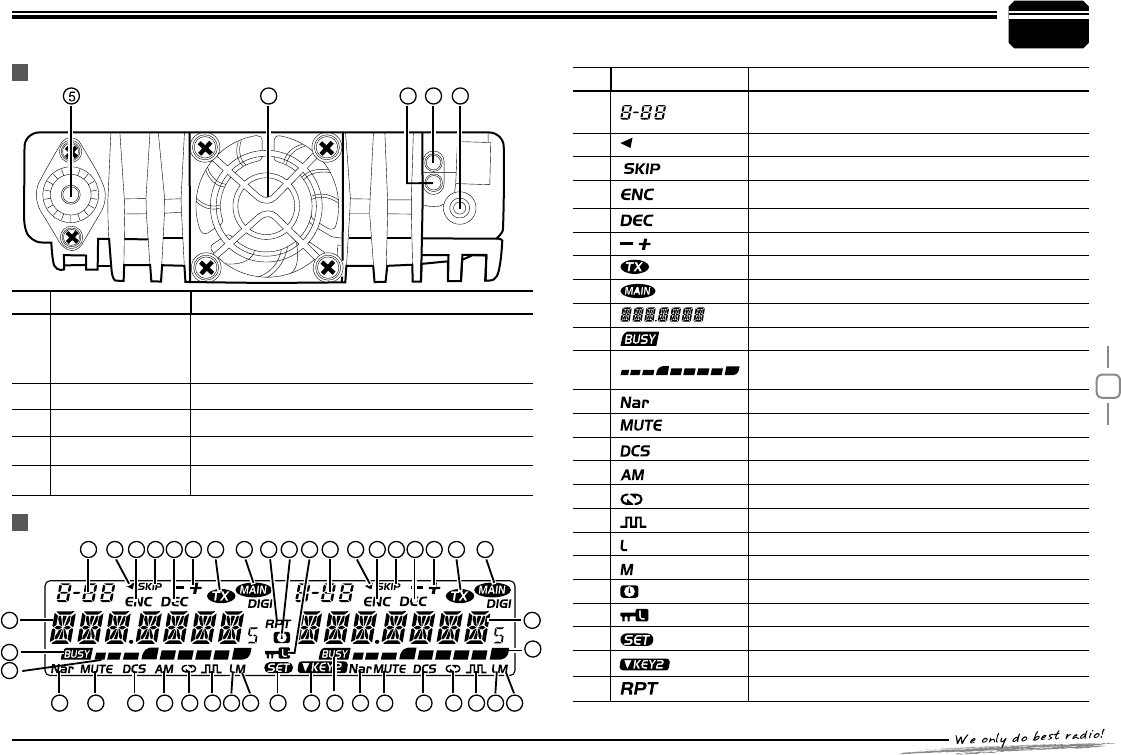
9
4
NO. KEY FUNCTION
1 Ext. Power Jack
Terminal for connecting optional cable QCC01 for
use with ignition key On/Off function.The radio will
auto power on when car is driving. The radio will
auto power off when car stops.
2Ext.Speaker Terminal Terminal for optional external speaker SP02
3 TV/AV port Connect to television TV/AV port. (Optional)
4 Heat -sink fan Runs Automatically when radio temperature rise up.
5 Antenna Connector Connect a 50 Ω antenna
NO. INDICATOR FUNCTION
1Displays the channel number and Menu number.
2Appears when current channel priority channel
3Appears when current channel is set Scan Skip
4Appears when current channel has CTCSS Encode
5Appears when current channel has CTCSS Decode
6Appears when the Offset function is ON
7Appears while transmitting.
8Displays the Main channel.
9Displays the operating frequency,channel name
10 Displays when receiving a signal or Monitor is ON
11 Signal strength for receiving and power level for
transmitting
12 Appears while in Narrow band.
13 Appears when mute has been turned ON.
14 Appears when the DCS function is ON.
15 Appears while in AM mode
16 Appears when the Scrambler function is ON
17 Appears when the Compander function is ON.
18 Appears while using Low output power
19 Appears while using Middle output power
20 Appears while Auto power off function is ON.
21 Appears when the Key Lock function is ON.
22 Appears when press SET key.
23 Appears when choose KEY2 mode.
24 Appears when corss band repeat function is ON
Getting Acquainted
REAR PANEL
DISPLAY
4 132
1 1
10
11
11
12 1213 1314 1415 1616
21
22
17 1718 1819 19
20
23
24
9
8
2 534 6 7 8
2 534 6 7
99
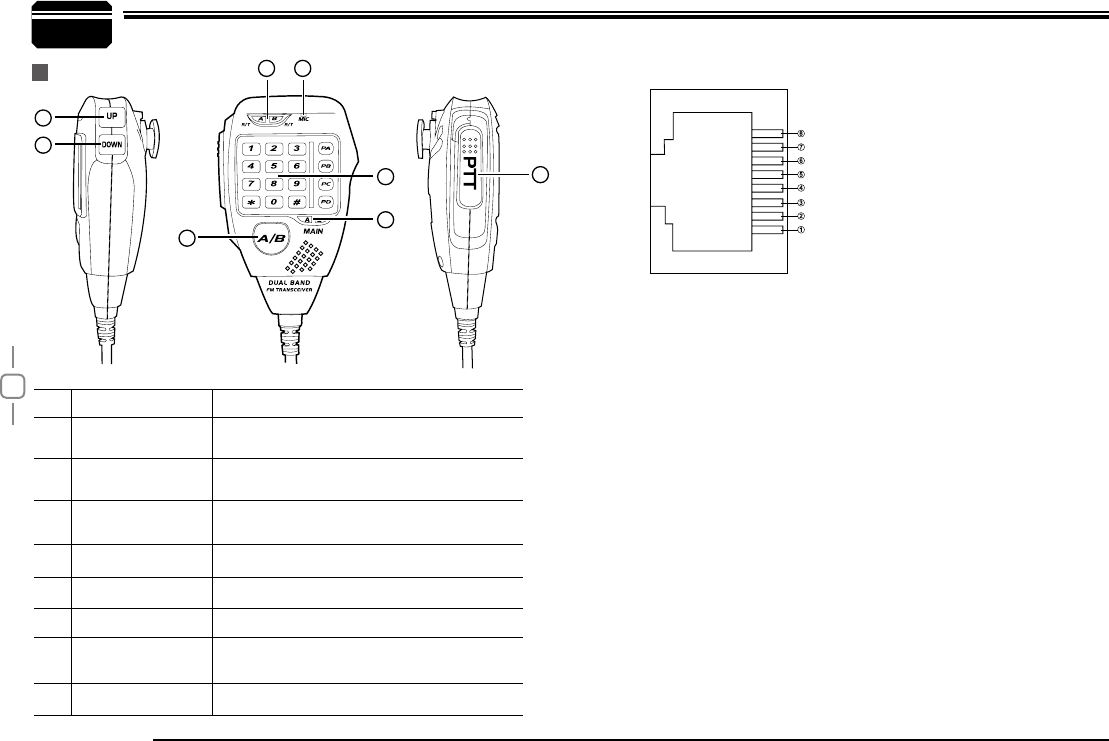
10
5888UV
4
NO. KEY FUNCTION
1 UP Increase frequency ,channel number or
setting value.
2 DOWN Decrease frequency, channel number or
setting value.
3 PTT Press the PTT (Push-TO-Talk) key to
transmit.
4 Number Key Input VFO frequency or DTMF dial out etc.
5 A/B band Choose left band or right band as Main band
6 Band Indicator The indicator light on for Main band.
7 TX/RX Indicator Light green while receiving, Light red while
transmitting.
8 MIC Speak here during transmission.
MIC Connector Diagram(in the front view of connector)
Getting Acquainted
MICROPHONE
Key Pad Serial Data
+5V
DOWN
UP
MIC GND
MIC
PTT
GND
5
1
2
3
6
7 8
4
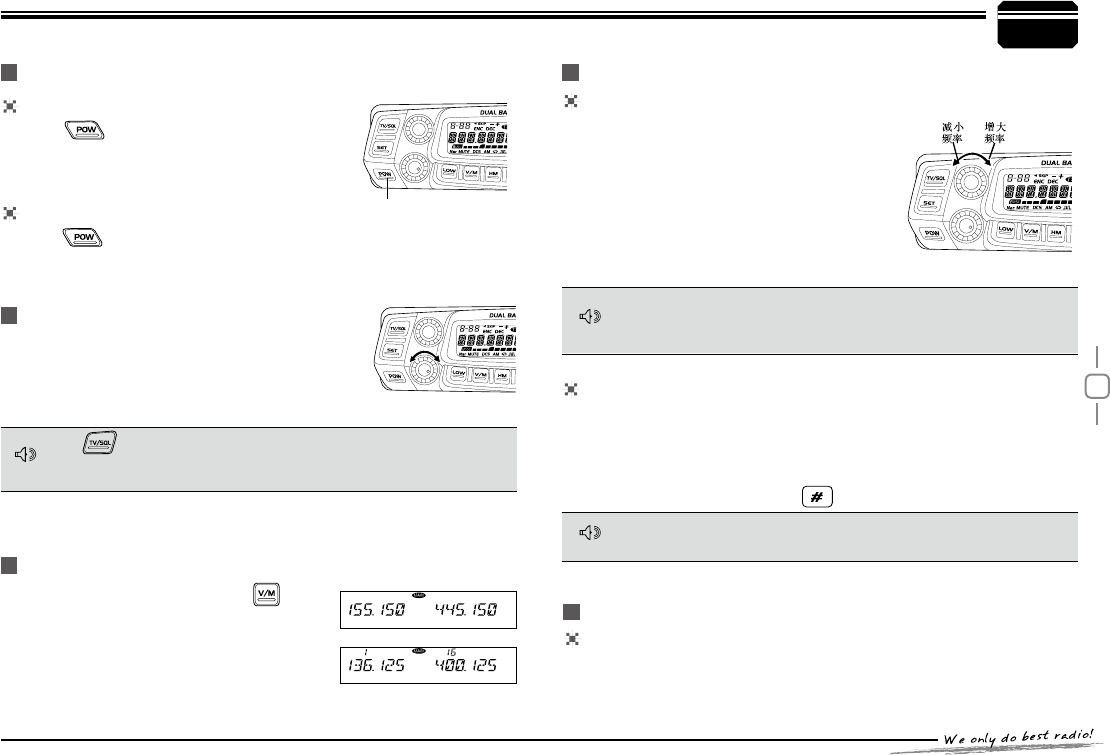
11
In standby, press correspondent key to
switch between Frequency and channel mode,
when the transceiver is in channel mode, the
LCD will displays current channel.
5Basic Operations
POWER ON
Press key to switch the transceiver ON,
the LCD displays "WELCOME ANYTONE", then
display current frequency or channel.
POWER OFF
Press key for over 0.5 Second to switch the transceiver OFF.
Rotate the [VOLUME] knob of selected
band clockwise to increase the volume,
counterclockwise to decrease the volume.
SWITCHING THE POWER ON/OFF
ADJUSTING THE VOLUME
SWITCH BETWEEN VFO AND CHANNEL MODE
ADJUSTING FREQUENCY
Hold , keep press Monitor the background noise after the transceiver
emits a DU beep, meanwhile adjust the [VOLUME] knob. During
communication, volume can be adjusted more accurate.
ADJUSTING FREQUENCY THROUGH SELECTOR KNOB
INPUT FREQUENCY THROUGH MICROPHONE NUMBER KEY
The microphone [ UP/DOWN ] key also able to adjust frequency.
Press [ UP/DOWN ] key will increase(decrease) the frequency by one
step size. Hold [ UP/DOWN ] key will adjust the frequency continuously.
When the Band lockout function is on, the input or adjusting of frequency
band. The right band only limited in 136-174Mhz and 400-470Mhz.
In frequency (VFO) mode, turn the selector
knob clockwise to increase frequency;
counterclock-wise to decrease frequency. Every
gear will increase or decrease frequency by one
step. To adjust the Main band frequency, press
corre-spondent selector knob, the left side of
decimal point will ash. In this status, turn the
selector knob will increase or decrease frequency quickly by 1MHz step
In VFO mode, you can input the frequency by the microphone numeric
key. It is invalid to input frequency out of the frequency band.
For example:
to input 150.125Mhz, press 1, 5, 0, 1, 2, 5 continuously.
to input 152 MHz, press1, 5, 2, continuously.
ADJUSTING CHANNEL
ADJUSTING CHANNEL THROUGH SELECTOR KNOB
In the channel mode, you can adjust the channel directly by the channel
knob.Turn clockwise to increase one channel; turn counterclockwise
to decrease one channel.To adjust the Main band channel, press
POW
5
Min
Volume
Max
Volume
NOTE
NOTE
NOTE
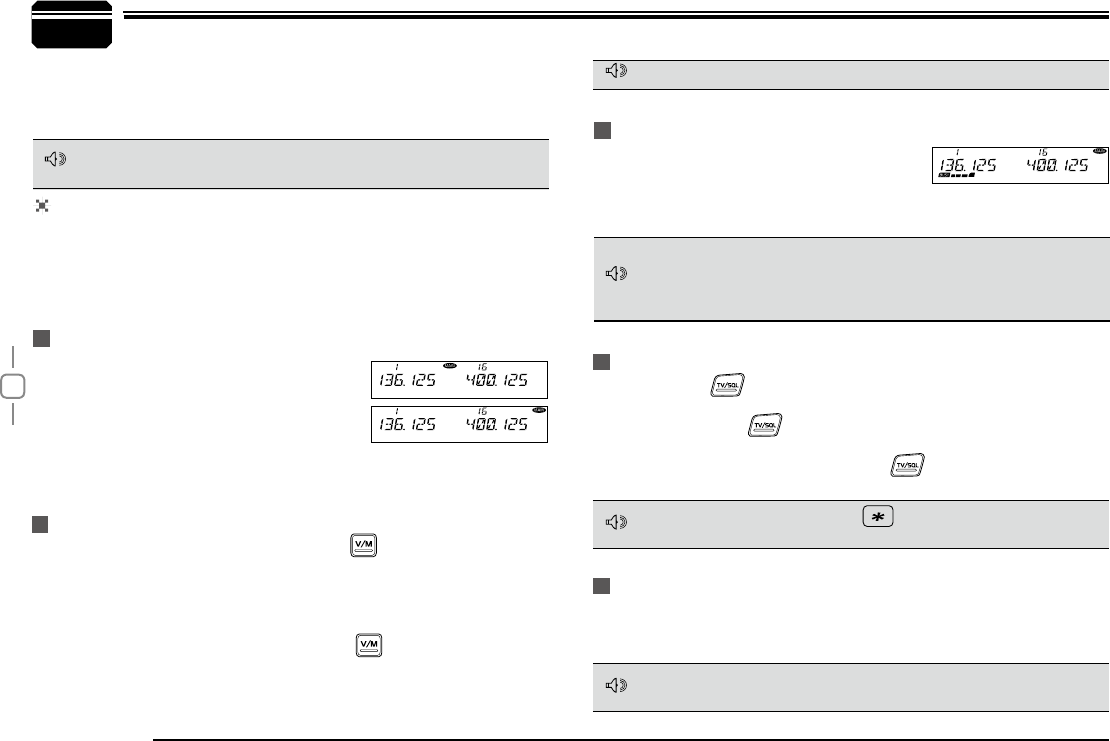
12
5888UV
SWITCH BETWEEN MAIN BAND AND SUB BAND
SELECTING THE FREQUENCY BAND
If there is any empty channel, the adjustment will ignore it and jump to
next channel.
This transceiver can be set working on 2 UHF band or 2 VHF band.
INPUT CHANNEL THROUGH MICROPHONE NUMBER KEY
In channel mode, you can switch to desired channel by press 3 of the
microphone numeric key (001-758). For example input 001 get channel 1;
input 030 is channel 30; input 512 is channel 512. If the input channel is
not programmed with frequency, the transceiver will emit a warning beep
and return to last channel.
This transceiver is default on dual receive,
a "MAIN" icon will displays in the top right of
the working frequency. The transmitting is only
on the Main band. When the left Band is Main
band, press the right selector knob will switch
the right Band to Main band. Then press the left selector knob will switch
the left Band to Main band.
1. Choose for Left band: press the left side key to switch it to VFO
mode, press the left selector knob over 1 second then repeater above
operation will switch the left band
.
2. Choose for right band: press the right side key to switch it to VFO
mode, press the right selector knob over 1 second then repeater
above operation will switch the right band
5
Basic Operations
RECEIVING
If the transceiver has set at higher squelch level, it may fail to hear the
calling. If the Busy and signal strength icon display inleft band or right
band, but can not hear the calling, means the signal is with matching
carrier but dis-matching signaling.
In standby, both left band and right band
able To receive. When they receive any signal,
the BUSY icon and signal strength icon will appear in the correspondent
area of the LCD. And you can hear the calling。
SQUELCH OFF/SQUELCH OFF MOMENTARY
Long press of key can be programmed as Squelch Off or Squelch
Off Momentary to monitor the weak signal.
1. Squelch Off: Hold key until hear "Du" beep, the squelch is off,
repeat the above operation to resume squelch.
2. Squelch Off Momentary: Keep hold key to disable squelch,
Release the key to resume squelch.
TRANSMITTING
Hold PTT key, the transceiver change to transmitting. Please hold the
mic-rophone approximately 2.5-5.0cm from your mouth, and then speak
into the microphone in your normal voice to get best timbre.
The transmitting only available on Main band, the TX icon will display in
the top right corner of the Main band frequen
In standby, press the microphone to cancel squelch, press it again
to turn on the squelch.
correspondent selector knob, the channel number flashes in this
situation, the channel number will increase 10 channels by each gear of
selector knob. Press microphone [ UP/DOWN ] key also able to adjust
the channel.
5
NOTE
NOTE
NOTE
NOTE
NOTE
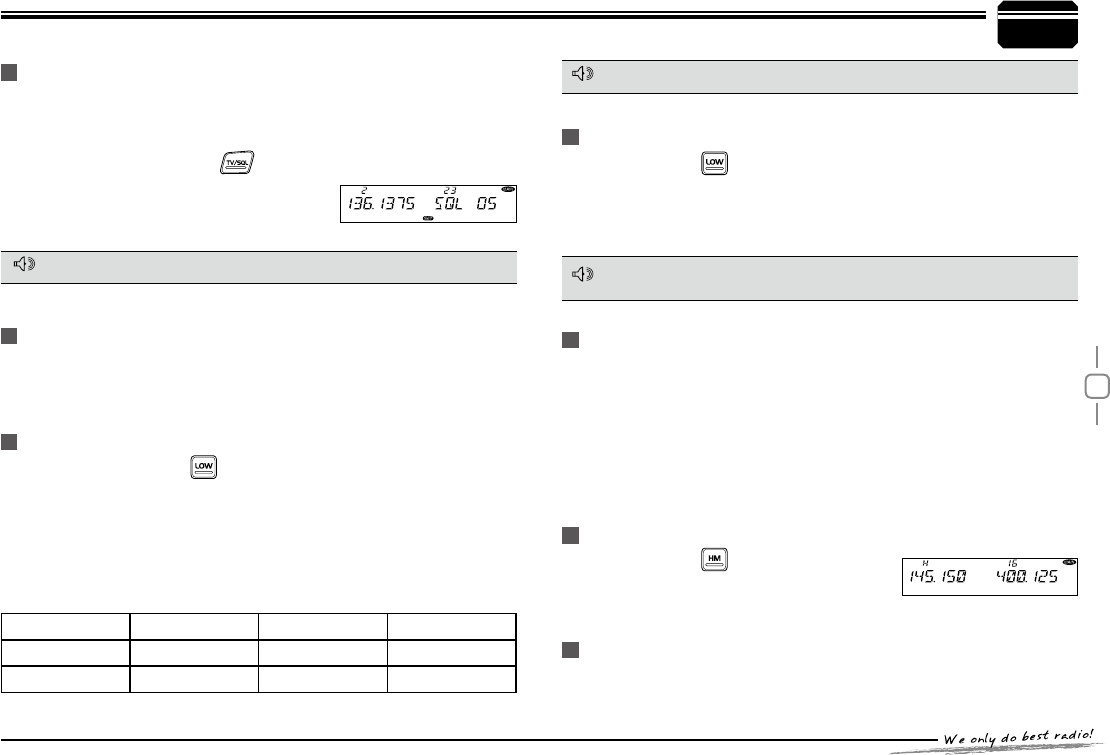
13
SQUELCH OFF/SQUELCH OFF MOMENTARY
6Shortcut Operations
SQUELCH LEVEL SETUP
his function is used to setup the strength of receiving signal, when the
stren gth reach a certain level, the calling can be heard, otherwise, the
transceiver will keep mute.
In standby, press and hold key, meanwhile switch the selector
knob to adjust the squelch level of Main band.
1-20: Total 20 squelch levels available.
OFF: turn off squelch. The background noise always on.
The squelch level shall setup separately for right band and left band.
TRANSMIT DTMF/2TONE/5TONE SIGNALING
If the current channel is with DTMF/2TONE/5TONE signaling, hold PTT
and [ UP ] key will transmit selected Pre-programmed signaling
HIGH/MID/LOW POWER SWITCH
In standby, repeat press key to choose power levels as following:
When LCD displays HIGH, the power on current channel is high.
When LCD displays MID1, the power on current channel is middle 1
When LCD displays MID2, the power on current channel is middle 2.
When LCD displays LOW, the power on current channel is low.
Output power for each level:
HIGH MID1 MID2 LOW
VHF(50W) VHF(20W) VHF(10W) VHF(5W)
UHF(40W) UHF(20W) UHF(10W) UHF(5W)
In channel mode, this operation is for temporary use only
This function is valid only when current channel setup with offset frequency
and offset direction
In standby, press key to switch to HOME
channel, and commnicatte on HOME channel.
repeat press it to return to last channel.
In standby, hold key for over 0.5second to turn On/ Off frequency
reverse function. When reverse function is on, the TX frequency will
change to RX frequency and RX frequency change to TX frequency.
The signaling will also be reversed if CTCSS/DCS signaling existed in
this channel.
HOME CHANNEL
FREQUENCY REVERSE
This transceiver has 1 band widths
In standby, hold key for over 0.5 second to choose the 1 band widths
When LCD displays NARROW, current channel is work on narrow
band 12.5KHz
BA
ND-WIDTH SELECTION
6
NOTE
NOTE
NOTE
SUPER CHANNEL SELECT
In standby, press the left or right volume knob will switch the radio work
on super channel 1 or supper channel 2.
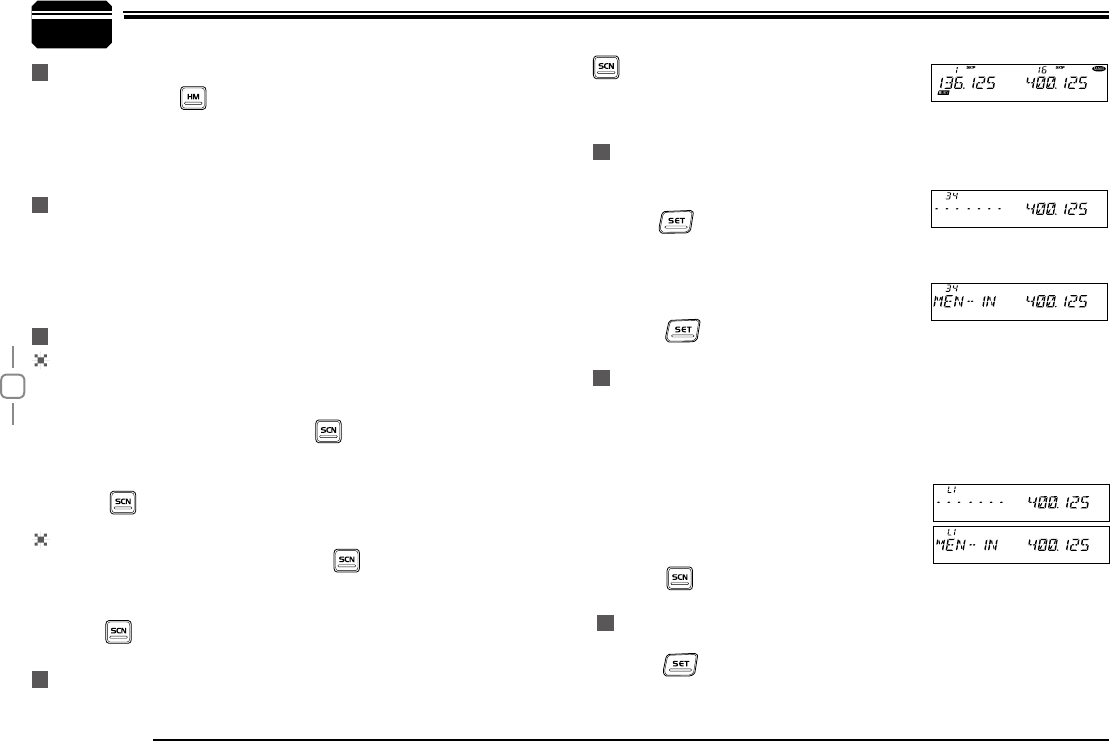
14
5888UV
Shortcut Operations
In standby, hold key for over 0.5 second to enter Dual Watch
mode. The radio will scan the channel in every 5 seconds. When the radio
receives match signal, it pause scanning until the signaling disappear.
Repeat above operation to exit Dual watch.
DUAL WATCH
FREQUENCY SCAN
CHANNEL/FREQUENCY SCAN
In VFO mode, this function is designed to monitor signal of every
communicative frequency point of "step size" you have set.
In VFO mode, press the Main Band
1. key to enter channel scan.
During the scanning adjust the Main band selector knob or press
2.
microphone [ UP/DOWN ] key will change the scan direction.
Press
3. key to exit scan.
CHANNEL SCAN
In channel mode, press the Main Band
1. key to enter channel scan.
During the scanning, adjust the Main band selector knob or press
2.
microphone [ UP/DOWN ] key will change the scan direction.
Press
3. key to exit scan.
In channel mode, switch selector knob to choose the channel, then hold
In VFO mode, turn selector knob to select the desired frequency or
1.
input frequency by MIC's numeric keys.
Hold
2. key until the transceiver prompt
DU and the display of channel number ashes.
Turn selector knob to select the channel number to store. (If the
3.
storage has data , the LCD will display the
frequency, otherwise will display----------)
Press
4. key, the LCD display MEN- IN, the channel edit completed.
In channel mode, turn the selector knob to choose the channel.
1.
Hold
2. key until the transceiver prompt a Du and channel number
display ashes.
Turn selector knob to choose channel number for storage. ( If the
3.
CHANNEL SCAN SKIP
CHANNEL EDIT
CHANNEL COPY
6
EMERGENCY ALARM
To start emergency alarm, hold the right volume knob until the trans
-ceiver displays ALARM and emit alarm. Re-power on the transceiver to
exit alarm. This transceiver has 4 kind of alarm which can be setup by
programming software.
6
for over 0.5 second, the radio prompts
"DU DU", and LCD displays "SKIP", and now
the current channel is Scan Skip.
SCAN RANGE LIMIT
You can set the VFO scan frequency range by this function:
Choose upper limit and lower limit frequency, there are L1/U1- L5/
1.
U5, five couple of limit frequency for selection. L stands for lower
limit and U stands for the upper limit. the upper limit must over the
lower limit frequency. Please refer the
Channel Edit to setup the limit frequency.
In VFO mode, set the VFO frequency in
2.
the range between upper and lower limit.
Press
3. key to start scan in lmited range.
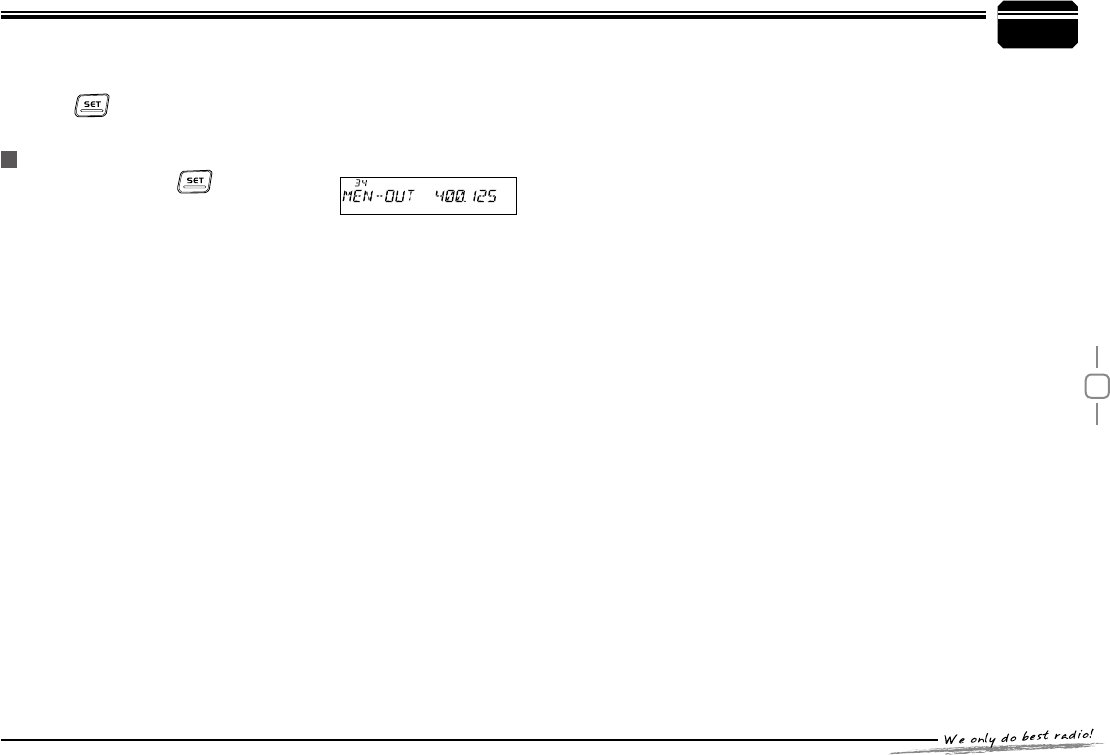
15
Shortcut Operations
In standby, hold
1. key unt il t he
transceiver prompt DU, and channel
number ashes.
Turn selector knob to choose channel number for delete. (If the
2.
storage has data, the LCD will display the frequency, otherwise will
display----------)
Hold Main band volume knob, until the transceiver emit DU DU
3.
prompt and LCD displays MEN-OUT, the channel delete completed.
CHANNEL DELETE
7
storage has data , the LCD will display the frequency, otherwise will
display----------)
Press
4. key, the LCD displays MEN-IN, channel copy completed.
6
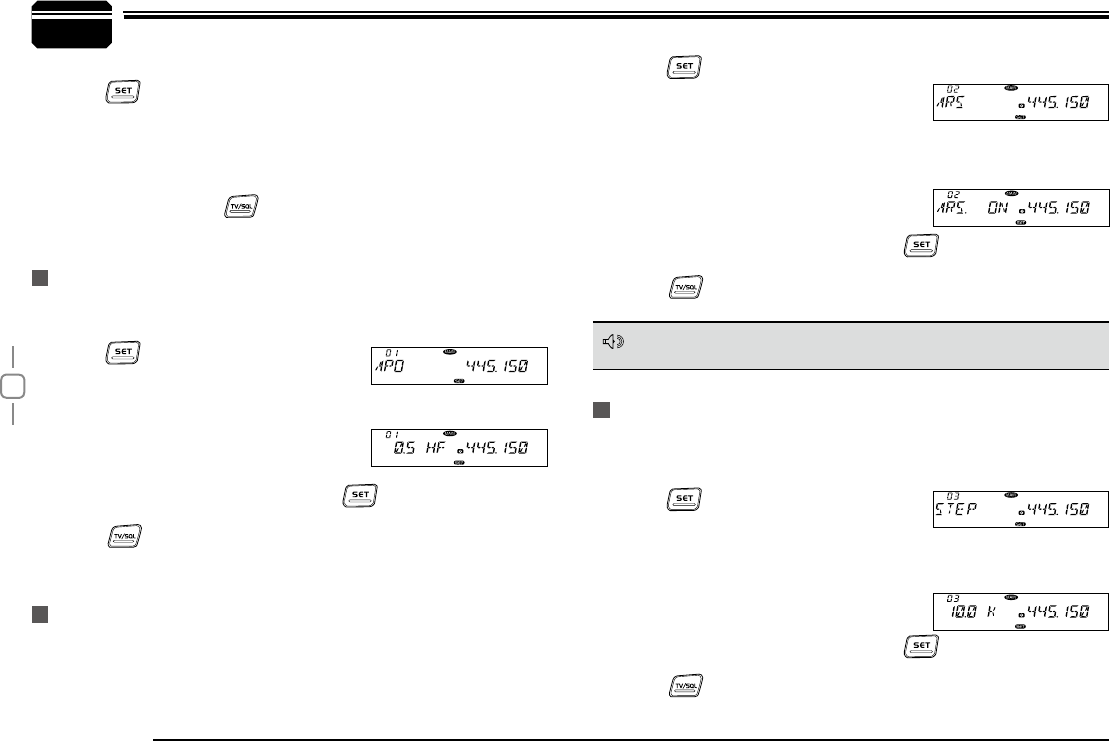
16
5888UV
General Setting
Once APO is activated, the transceiver will be automatically switched
off when the pre-set timer running out.
Press
1. key to enter function menu.
Turn the Main band selector knob to
2.
choose No. 01 menu. the LCD displays "APO"
Press the Main band selector knob to enter function setup.
3.
Switch the Main band selector knob to
4.
choose wanted value.Available Values:
0.5-12 hours, OFF
Press the Main band selector knob or
5. key to store value and
back to function menu.
Press key or hold selector knob for over 0.5 second to store
setup and exit.
Only in frequency (VFO) mode, this function is valid. Turn selector
knob to to select frequency or frequency scanning which is restricted by
frequency step size.
Press
1. key to enter function menu.
Turn the Main band selector knob to
2.
choose No. 03 menu. the LCD displays "STEP"
Press the Main band selector knob to enter function setup.
3.
Switch the Main band selector knob to choose wanted value.
4.
Available Values: 2.5K, 5K, 6.25K, 10K,
12.K, 15K, 20K, 25K, 30K,50K.
Press the Main band selector knob or
5. key to store value and
back to function menu.
Press key or hold selector knob for over 0.5 second to store
setup and exit.
This transceiver has automatic offset function. When this function is on,
the transceiver will automatically transmitting with RX frequency ± offset
frequency. The operation as following:
APO (AUTOMATIC POWER OFF)
FREQUENCY CHANNEL STEP SETUP
AUTOMATIC OFFSET
operation steps of Function menu
Press
1. key to enter function menu.
Turn the Main band selector knob to choose wanted function.
2.
Press the Main band selector knob to enter function setup.
3.
Switch the Main band selector knob to choose wanted value.
4.
Press the Main band selector knob to store value and back to
5.
function menu. Press key or hold selector knob for over 0.5
second to store setup and exit.
Press
1. key to enter function menu.
Turn the Main band selector knob to
2.
choose No. 02 menu. the LCD displays
"ARS"
Press the Main band selector knob to enter function setup
3.
Switch the Main band selector knob to choose wanted value.
4.
ON: Auto Offset function is turned on.
OFF Auto Offset function is turned off.
Press the Main band selector knob or
5. key to store value and
back to function menu.
Press key or hold selector knob for over 0.5 second to store
setup and exit.
When the Automatic offset is ON, the offset for 136-174Mhz is default on
0.6Mhz, and for 400-490 is default on 5Mhz.
7
NOTE
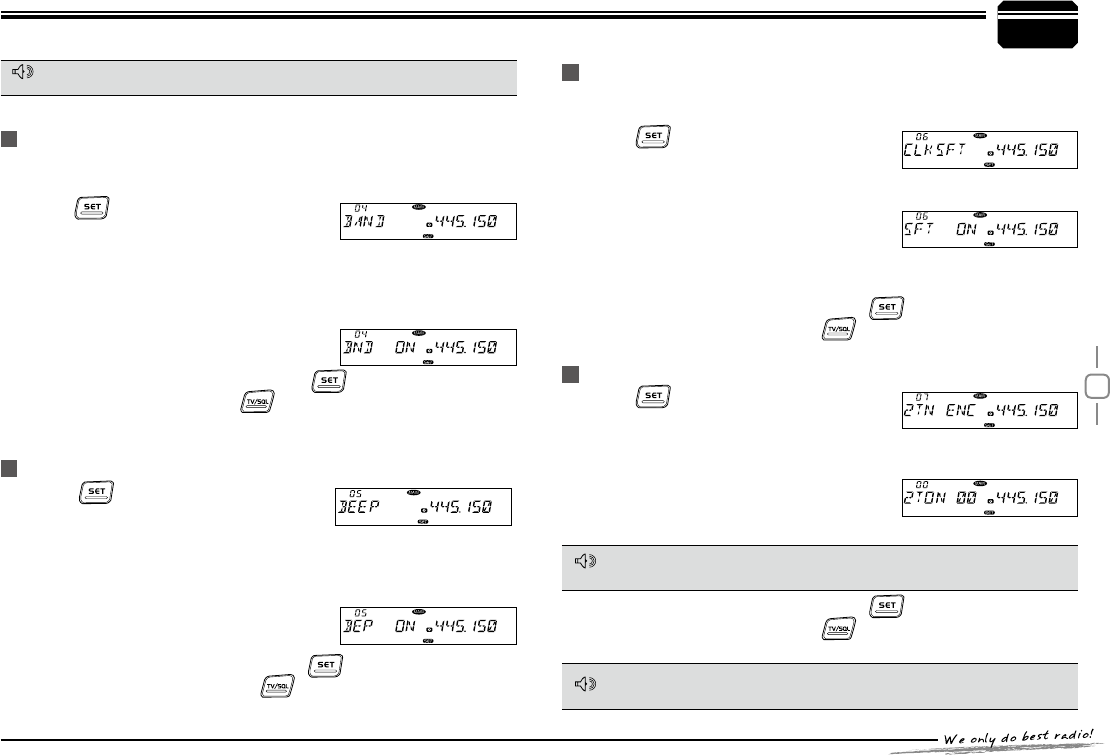
17
7
General Setting
In VFO mode, when this function is on, the scanning or input of
frequency will restricted within the current VFO frequency band.
Press
1. key to enter function menu.
Turn the Main band selector knob to
2.
choose No. 04 menu. the LCD displays "BAND"
Press the Main band selector knob to enter function setup.
3.
Switch the Main band selector knob to choose wanted value.
4.
ON: Turn on VFO band lockout function
OFF: Turn off VFO band lockout function
Press the Main band selector knob or
5. key to store value and
back to function menu. Press key or hold selector knob for over
0.5 second to store setup and exit.
Press
1. key to enter function menu.
Turn the Main band selector knob to
2.
choose No. 05 menu. the LCD displays "BEEP"
Press the Main band selector knob to enter function setup.
3.
Switch the Main band selector knob to choose wanted value.
4.
ON: Turn on Beep function.
OFF: Turn off Beep function
Press the Main band selector knob or
5. key to store value and
back to function menu. Press key or hold selector knob for
over 0.5 second to store setup and exit.
When any harmonic or image frequency in the CPU clock disturbs the
working frequency, turn on this function will cut the disturbing
Press
1. key to enter function menu.
Turn the Main band selector knob to
2.
choose No. 06 menu. the LCD displays "CLK.SFT"
Press the Main band selector knob to enter function setup.
3.
Switch the Main band selector knob to
4.
choose wanted value.
ON: Turn on CPU Clock frequency Change
OFF: Turn off CPU Clock frequency Change
Press the Main band selector knob or
5. key to store value and
back to function menu. Press key or hold selector knob for
over 0.5 second to store setup and exit.
Press
1. key to enter function menu.
Turn the Main band selector knob to
2.
choose No. 07 menu. the LCD displays "2TN ENC"
Press the Main band selector knob to enter function setup.
3.
Switch the Main band selector knob to
4.
choose wanted value.
Available Values: 0-23, total 24 groups.
VFO BAND LOCKOUT
BEEP FUNCTION
CPU CLOCK FREQUENCY CHANGE
2TONE ENCODE SELECT
This function is auto-hidden in channel mode
if the 2TONE encode are programmed with name, the LCD will display
correspondent name.
After choose the 2TONE encode group. Press PTT will transmit selected
code.
Press the Main band selector knob or
5. key to store value and
back to function menu. Press key or hold selector knob for
over 0.5 second to store setup and exit.
7
NOTE
NOTE
NOTE
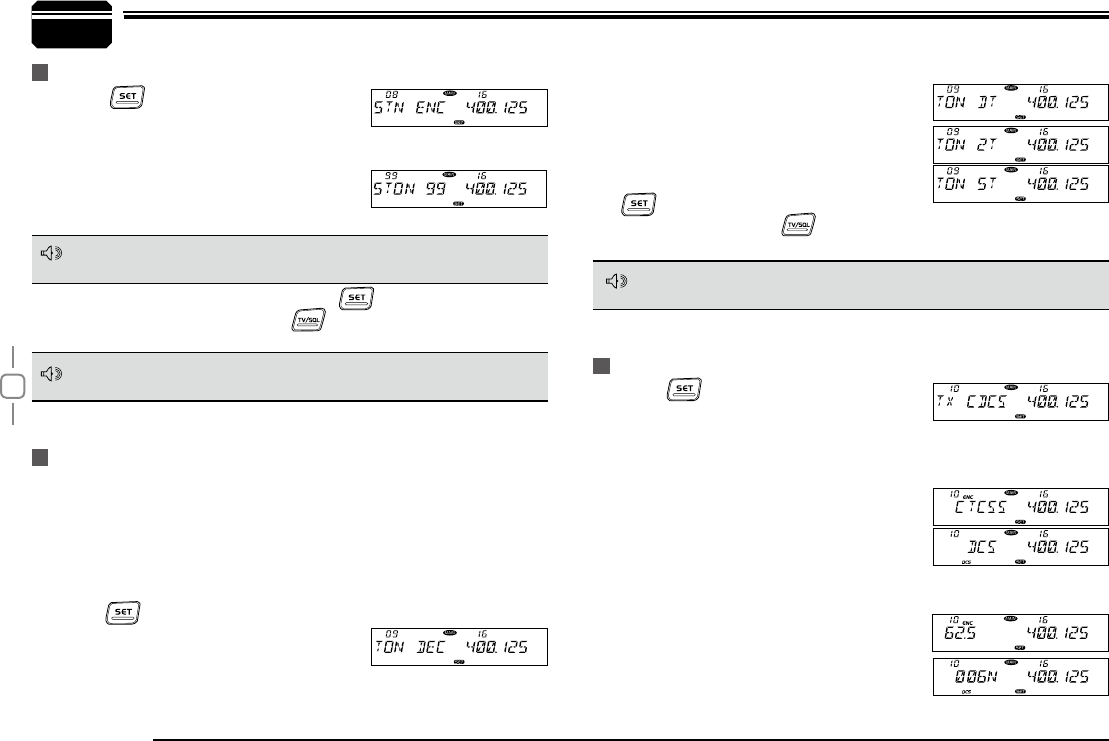
18
5888UV
7General Setting
Press
1. key to enter function menu.
Turn the Main band selector knob to
2.
choose No. 08 menu. the LCD displays "5TN ENC"
Press the Main band selector knob to enter function setup.
3.
Switch the Main band selector knob to
4.
choose wanted value.
Available Values: 0-99, total 100 groups.
This transceiver has 3 optional signaling: DTMF/5Tone/2Tone,those
signaling function similar as CTCSS/DCS signaling. When the receiver
adds an optional signaling, the caller shall transmit matching signaling.
DTMF and 5Tone signaling can be applied for other advanced features
such as ANI, PTT ID, group call, select call, remotely stun, remotely kill
waken…etc
Press
1. key to enter function menu.
Turn the Main band selector knob to
2.
choose No. 09 menu. the LCD displays
"TON DEC"
Press the Main band selector knob to enter function setup.
3.
Press
1. key to enter function menu.
Switch the Main band selector knob to
2.
choose No 10 menu, the LCD displays "TX CDCS"
Press the Main band selector knob to enter function setup.
3.
Switch the Main band selector knob to choose wanted value
4.
OFF: Turn off CTCSS/DCS encode.
CTCSS: Choose CTCSS encode.
DCS: Choose DCS encode.
Press the Main band selector knob to enter the menu.
5.
Switch the Main band selector knob to choose wanted CTCSS, DCS
6.
code.
CTCSS: 62-254.1Hz, and one self-dene
group, total 52 groups
DCS: 000N-777I, total 1024 groups
5TONE ENCODE SELECT
ADD OPTIONAL SIGNALING
CTCSS ENCODE SETUP
Press the Main band selector knob or
5. key to store value and
back to function menu. Press key or hold selector knob for
over 0.5 second to store setup and exit.
if the 5TONE encode are programmed with name, the LCD will display
correspondent name.
After choose the 5TONE encode group. Press PTT will transmit selected
code.
The working of optional signaling shall be work associated with the squelch
mode setup. (Refer to Squelch Mode setup in page 19)
Switch the Main band selector knob to choose wanted value
4.
DTMF: means DTMF signaling is added.
2TONE: means DTMF signaling is added.
5TONE: means DTMF signaling is added.
OFF: Turn off optional signaling
Press the Main band selector knob or
5.
key to store value and back to
function menu.Press key or hold selector knob for over 0.5
second to store setup and exit.
7
NOTE
NOTE
NOTE
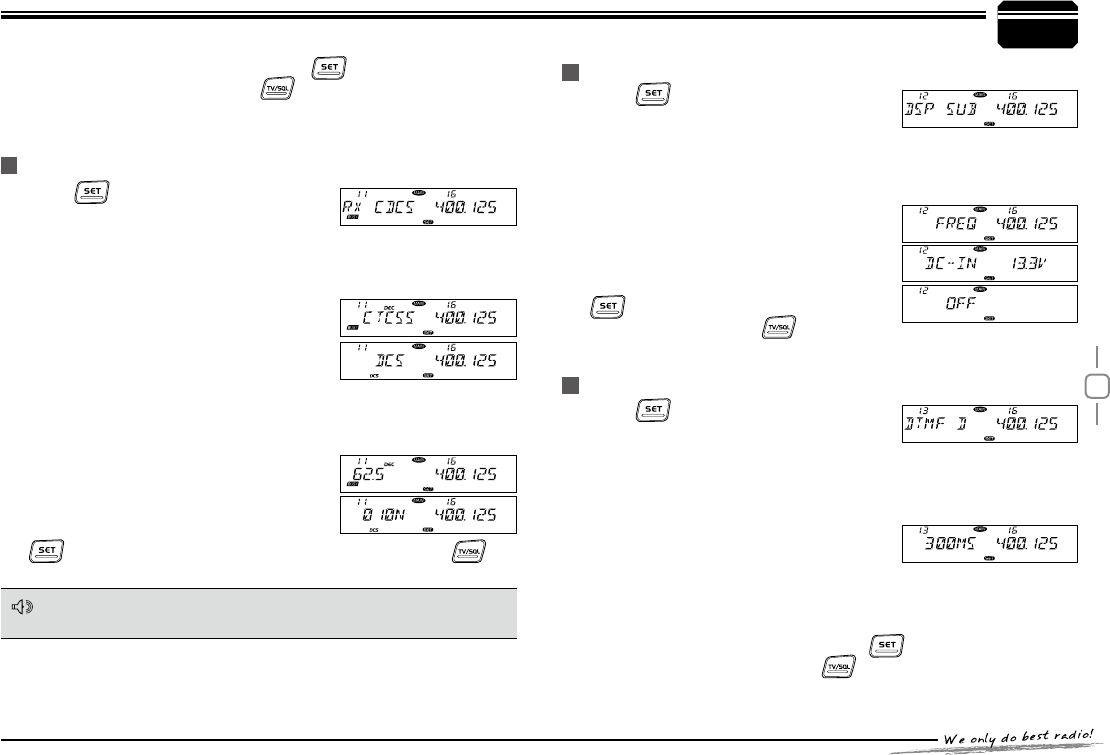
19
7
General Setting
Press
1. key to enter function menu.
Switch the Main band selector knob to
2.
choose No 11 menu, the LCD displays "RX CDCS"
Press the Main band selector knob to enter function setup
3.
Switch the Main band selector knob to choose wanted value
4.
OFF: Turn off CTCSS/DCS decode.
CTCSS: Choose CTCSS decode.
DCS: Choose DCS decode.
Press the Main band selector knob to enter the menu.
5.
Switch the Main band selector knob to choose wanted CTCSS, DCS
6.
code.
CTCSS: 62-254.1Hz, and one self-dene
group, total 52 groups
DCS: 000N-777I, total 1024 groups
Press the Main band selector knob or
7.
key to store value and back to function menu. Press key
or hold selector knob for over 0.5 second to store setup and exit.
Press
1. key to enter function menu.
Turn the Main band selector knob to
2.
choose No. 12 menu. the LCD displays "DSP SUB"
Press the Main band selector knob to enter function setup
3.
Switch the Main band selector knob to choose wanted value.
4.
FREQ: display sub band frequency,
DC-IN: display sub bad voltage.
OFF: turn off display for sub Band
Press the Main band selector knob or
5.
key to store value and back to
function menu. Press key or hold
selector knob for over 0.5 second to store setup and exit.
Press
1. key to enter function menu.
Turn the Main band selector knob to
2.
choose No. 13 menu. the LCD displays "DTMF D"
Press the Main band selector knob to enter function setup
3.
Switch the Main band selector knob to choose wanted value.
4.
100MS: The Pre-Loading time is 100MS
300MS: The Pre-Loading time is 300MS
600MS: The Pre-Loading time is 500MS
800MS: The Pre-Loading time is 800MS
1000MS: The Pre-Loading time is 1000MS
Press the Main band selector knob or
5. key to store value and
back to function menu. Press key or hold selector knob for
over 0.5 second to store setup and exit.
CTCSS DECODE SETUP
SUB BAND DISPLAY SETUP
DTMF ENCODE PRE-LOADING TIME
The working of CTCSS/DCS decode shall be work associated with the
squelch mode setup. (Refer to Squelch Mode setup in page 19)
Press the Main band selector knob or
7. key to store value and
back to function menu. Press key or hold selector knob for
over 0.5 second to store setup and exit.
7
NOTE
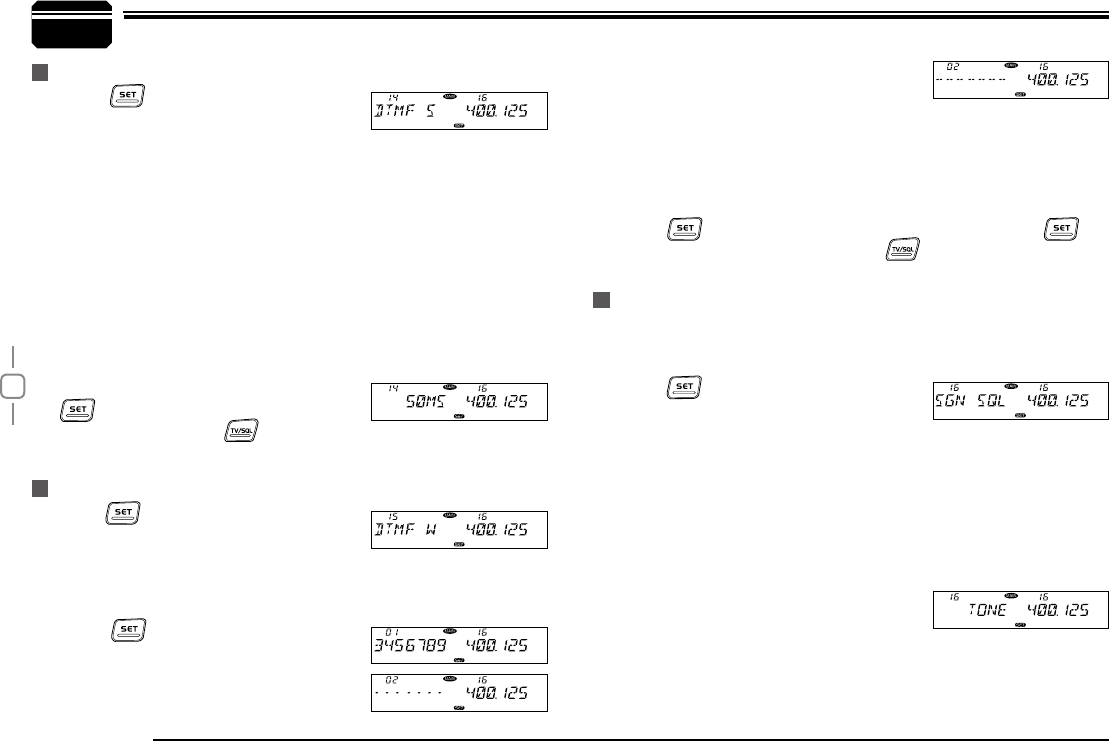
20
5888UV
7General Setting
Press
1. key to enter function menu.
Turn the Main band selector knob to
2.
choose No 14 menu. The LCD displays "DTMF S"
Press the Main band selector knob to enter function setup.
3.
Switch the Main band selector knob to choose wanted value.
4.
30MS: The time for transmit a single DTMF encode and the interval is 30MS,
50MS: The time for transmit a single DTMF encode and the interval is 50MS,
80MS: The time for transmit a single DTMF encode and the interval is 80MS,
100MS: The time for transmit a single DTMF encode and the interval is 100MS,
150MS: The time for transmit a single DTMF encode and the interval is 150MS,
200MS: The time for transmit a single DTMF encode and the interval is200MS,
250MS: The time for transmit a single DTMF encode and the interval is 250MS,
Press the Main band selector knob or
5.
key to store value and back to
function menu. Press key or hold selector knob for over 0.5
second to store setup and exit.
Press
1. to enter function menu
Switch the Main band selector knob to
2.
choose No 15 menu, the LCD displays DTMF W
Press the Main band selector knob to enter function setup.
3.
Switch the Main band selector knob to choose DTMF group. Then
4.
press key back to DTMF menu.
Press PTT will transmit with selected
DTMF code.
06-16: total 16 group of DTMF code.
DTMF ENCODE TRANSMITTING TIME
DTMF ENCODE SETUP
When the selected group is empty, the
5.
LCD displays '------"
Press the selector knob to enter the DTMF signaling edit. The LCD
6.
display "-- -- -- -- -- --", the last character ashes.
Switch the selector knob to choose wanted character. Press the
7.
selector knob to confirm selected value and start edit for next
character.
Press
8. key to store value and exit code editing. Press key
again to store setup and exit. Press key or hold selector knob
for over 0.5 second to store setup and exit.
This transceiver has 5 squelch modes available. Squelch function is
used for increase the level of filtering unwanted signal, and free from
disturb.
Press
1. key to enter function menu.
Turn the Main band selector knob to
2.
choose No 16menu. The LCD displays "SGN SQL"
Press the Main band selector knob to enter function setup.
3.
Switch the Main band selector knob to choose wanted value
4.
SQ: You can hear the calling once receives matching carrier.
CTSS/DCS: You can hear the calling when receives matching carrier
and CTCSS/DCS code.
CT*TO: You can hear the calling when receives matching carrier +
optional signaling.
TONE: You can hear the calling when
receives matching carrier + CTCSS/DCS + optional
signaling.
CT/TO: You can hear the calling when receives any matching carrier
or CTCSS/DCS or optional signaling.
SQUELCH MODE SETUP
7
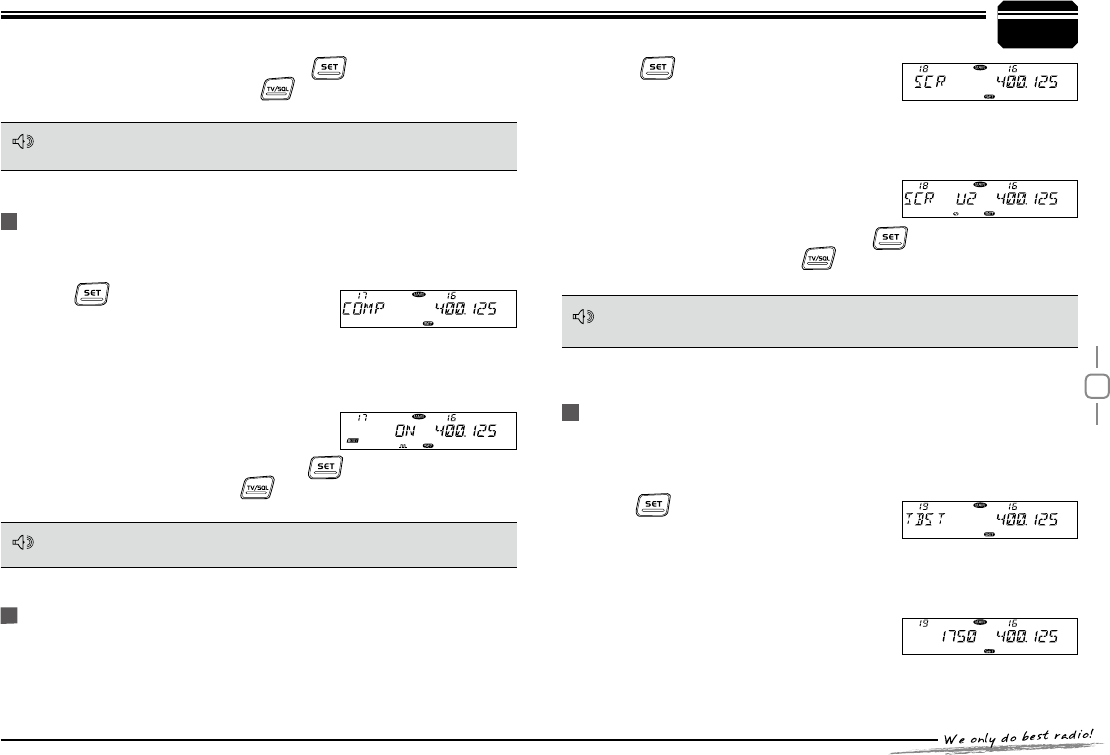
21
7
General Setting
Compander function will decrease the background noise and enhance
audio clarity, especially in long range communication.
Press
1. key to enter function menu
Turn the Main band selector knob to
2.
choose No 17 menu. The LCD displays "COMP"
Press the Main band selector knob to enter function setup.
3.
Switch the Main band selector knob to choose wanted value.
4.
ON: Compander function is turn on
OFF: Compander function is turn off
Press the Main band selector knob or
5. key to store value and
back to function menu. Press key or hold selector knob for over
0.5 second to store setup and exit.
This special audio process can offer a more confidential
communication;other radio with at same frequency will receive only
disordered noises.
This function uses to start repeater .It needs certain intensity Pilot
Frequency to start a dormant repeater. As usual, no need to send pilot
frequency again once repeater started.
Press
1. key to enter function menu.
Turn the Main band selector knob to
2.
choose No 19 menu. The LCD displays "TBST"
Press the Main band selector knob to enter function setup.
3.
Switch the Main band selector knob to choose wanted frequency.
4.
1000: Pilot Frequency is 1000Hz.
1450: Pilot Frequency is 1450Hz.
1750: Pilot Frequency is 1750Hz.
2100: Pilot Frequency is 2100Hz.
COMPANDER
SCRAMBLER SETUP
TONE BUST (PILOT FREQUENCY)
Press the Main band selector knob or
5. key to store value and
back to function menu. Press key or hold selector knob for
over 0.5 second to store setup and exit.
When using compander, to avoid distortion during communications, both
radios need turn on this function.
Only when the transceiver is set with CTCSS/DCS or optional
DTMF/5TONE/TONE signaling, the values will be available.
To enable commutation with scrambler, 2 transceivers shall set with same
group.
Press
1. key to enter function menu.
Turn the Main band selector knob to
2.
choose No 18 menu. The LCD displays "SCR"
Press the Main band selector knob to enter function setup.
3.
Switch the Main band selector knob to choose wanted group
4.
1-9 (9 fix groups)U1,U2 (2 self defined
scrambler groups)
Press the Main band selector knob or
5. key to store value and
back to function menu. Press key or hold selector knob for over
0.5 second to store setup and exit.
7
NOTE
NOTE
NOTE
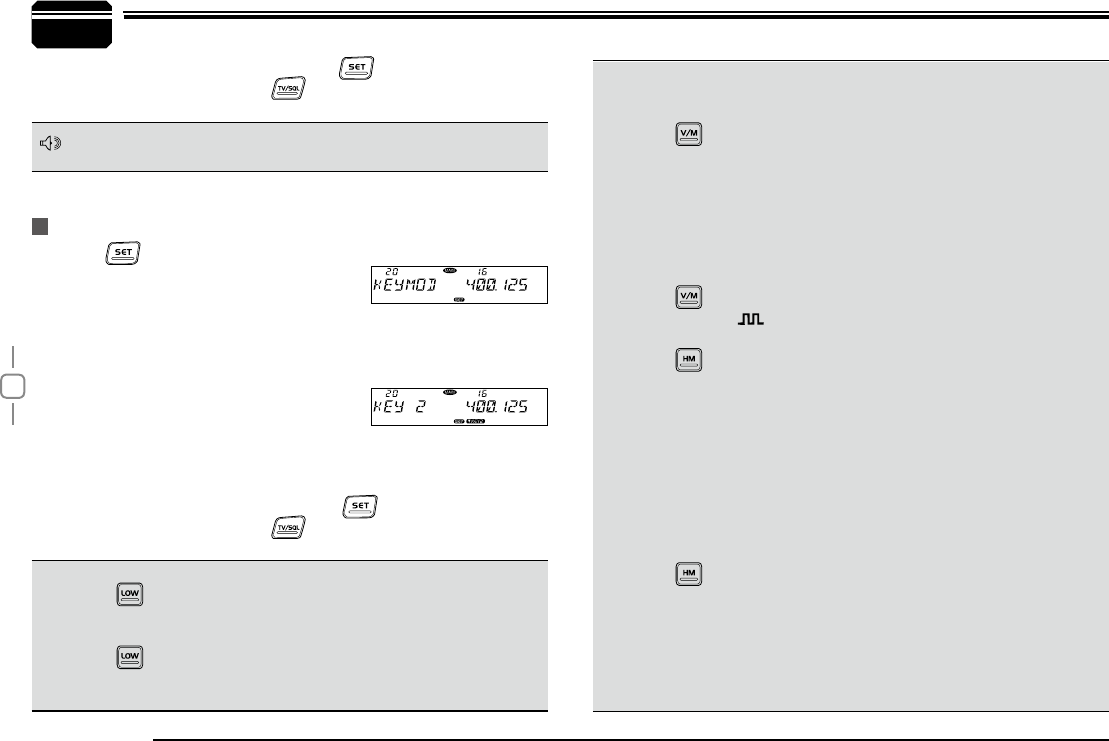
22
5888UV
7General Setting
Press the Main band selector knob or
5. key to store value and
back to function menu. Press key or hold selector knob for over
0.5 second to store setup and exit.
Short press: In VFO mode, short press this key, the
frequency step size changes to 1Mhz,in channel mode,
adjust selector knob will jump 10 channels.
long press: In standby, long press this key to ad/delete
optional signaling, repeat the long press it, will set optional
signaling DTMF,5TONE or 2TONE. When the LCD displays
After the above setup, hold microphone PTT key and [ DOWN ] key, the
radio will transmit selected tone.
Press
1. key to enter function menu.
Turn the Main band selector knob to
2.
choose No 20 menu. The LCD displays
"KEYMOD"
Press the Main band selector knob to enter function setup.
3.
Switch the Main band selector knob to choose wanted mode.
4.
KEY1: key1 mode, Normal mode, the left
4 keys have same functions as the
right 4 keys.
KYE2: the left 4 keypads will shared by both band. And the right 4
key pads will re-dened.
Press the Main band selector knob or
5. key to store value and
back to function menu. Press key or hold selector knob for over
0.5 second to store setup and exit.
KEYPAD MODE SETUP
DT means DTMF, displays 5T means 5TONE, displays 2T
means 2TONE. In VFO mode, long press this key, the step
size change to 10Mhz.
short press: Frequency reverse function, when current
channel is setup with offset direction and offset frequency,
press this key will turn on frequency reverse function. When
frequency reverse function the TX frequency turns to RX
frequency & RX frequency changes to TX frequency. The
signaling will also be reversed if CTCSS/DCS signaling
existed in this channel. Repeat shot press it will turn off
Frequency reverse function.
long press: In stand by, hold this key until the LCD
displays , means the compander function is on, repeater
above operation to turn off compander function.
short press: In standby, press this key to set the
CTCSS/DCS code for current channel.
When the LCD displays ENC, the current channel is with
CTCSS encode function.
When the LCD displays ENC and DEC, the current channel
is with CTCSS /DCS code function.
When the LCD displays DCS and DCS icon, the current
channel is with CTCSS code function.
When the LCD displays OFF, the current channel is without
CTCSS /DCS function.
long press: In standby, long press this key to enter
CTCSS/DCS scan, when nd matching CTCSS/DCS signal,
the scan will pause in the way lowing Scan Dwell time.
The scan direction can be changed by corresponding
channel selector knob.
Note:To enable this function, the channel shall be
programmed with CTCSS/DCS decode.
7
NOTE
Notice: Denition of 4 Right band Keypad in KEY2 mode:
3.
4.
5.
6.
1.
2.
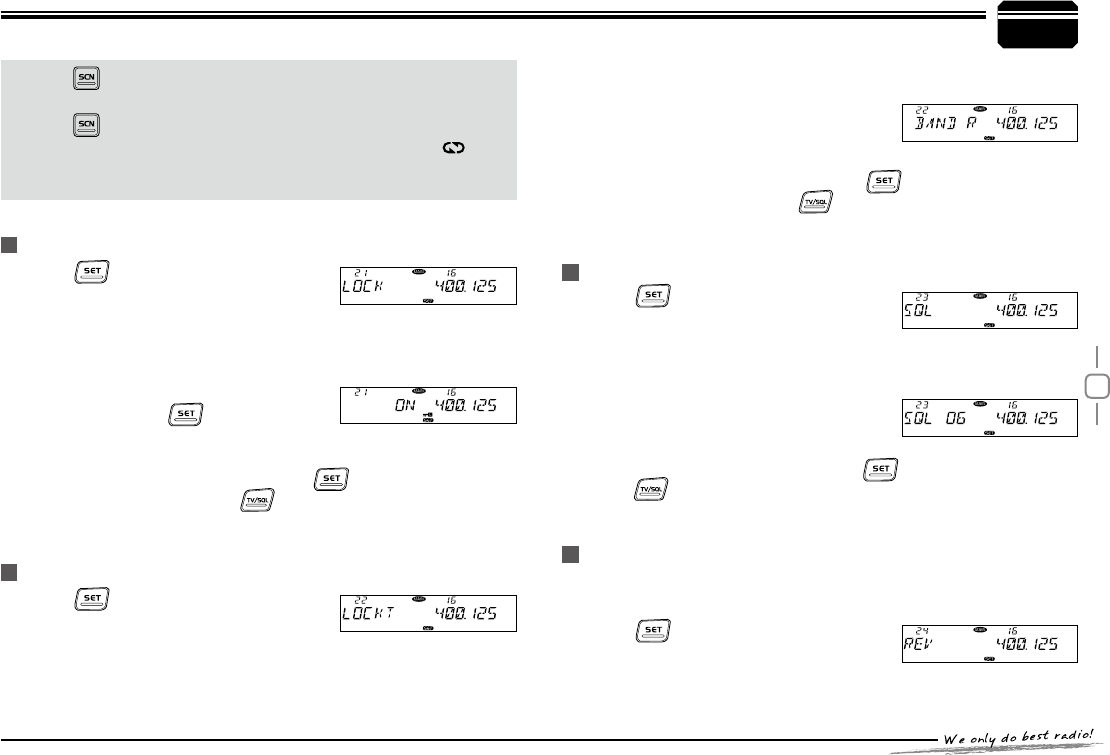
23
7
General Setting
Press
1. key to enter function menu.
Turn the Main band selector knob to
2.
choose No 21 menu. The LCD displays "LOCK"
Press the Main band selector knob to enter function setup.
3.
Switch the Main band selector knob to choose wanted mode.
4.
ON: The keypad lockout function is turn
on all keys beside and band switch
knob is valid.
OFF: The keypad lockout function is turn off.
Press the Main band selector knob or
5. key to store value and
back to function menu. Press key or hold selector knob for over
0.5 second to store setup and exit.
Press
1. key to enter function menu.
Turn the Main band selector knob to
2.
choose No 22 menu. The LCD displays "LOCKT"
Press the Main band selector knob to enter function setup.
3.
Switch the Main band selector knob to choose wanted mode.
4.
Press
1. key to enter function menu.
Turn the Main band selector knob to
2.
choose No 23 menu. The LCD displays "SQL"
Press the Main band selector knob to enter function setup.
3.
Switch the Main band selector knob to choose wanted value
4.
1-20: total 20 squelch levels
OFF: Turn of squelch function, the
background noise keep on.
Press the Main band selector knob or
5. key to store value and .
Press key or hold selector knob for over 0.5 second to store setup
and exit.
With this function on, the transceiver will able to communicate with a
trans ceiver in same network without through a repeater.
Press
1. key to enter function menu.
Turn the Main band selector knob to
2.
choose No 24 menu. The LCD displays "REV"
Press the Main band selector knob to enter function setup.
3.
KEYPAD LOCKOUT
TX OFF (PTT LOCKOUT)
SQUELCH LEVEL SETUP
TALK AROUND
short press, shot press this key , the sub band will
display "MAIN" and ashes.
ong press, choose scrambler group for Main band. In
standby, hold this key,the LCD displays SCR X and icon.
X stands for the group number, repeater above operation to
choose wanted group.
7.
8.
BAND R, lock the right band PTT. Only able to transmit by left band.
BAND L, lock the left band PTT. Only able to transmit by right band.
BAND BOTH, lock both band PTT. Not
able to transmit by any side.
OFF: PTT no lock.
Press the Main band selector knob or
5. key to store value and
back to function menu.Press key or hold selector knob for over
0.5 second to store setup and exit.
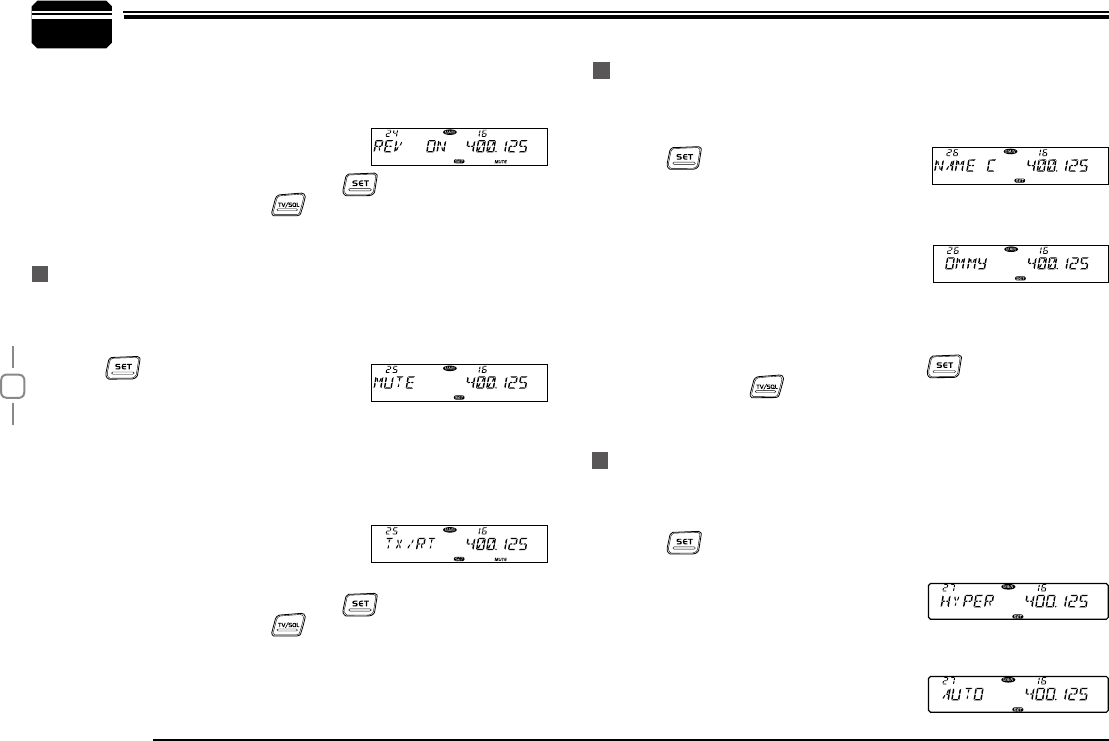
24
5888UV
General Setting
To avoid the receiving of sub band disturbing the communication of the
main band, you can turn on this function. The RX of the sub band will be
mute during the RX or TX of the main band.
Press
1. key to enter function menu.
Turn the Main band selector knob to
2.
choose No 25 menu. The LCD displays "MUTE"
Press the Main band selector knob to enter function setup.
3.
Switch the Main band selector knob to choose wanted value.
4.
TX: When the Main band is transmitting, the sub band receiving will
be mute.
RX: When the Main band is receiving, the
sub band receiving will be mute.
RX/TX: the sub band receiving always mute.
Press the Main band selector knob or
5. key to store value and
back to function menu. Press key or hold selector knob for over
0.5 second to store setup and exit.
SUB BAND MUTE SETUP
EDITING CHANNEL NAME
7
After edit a name for a channel, if the display mode is channel name,
the will displays the name edited in this menu. Otherwise it will display the
frequency.
Press
1. key to enter function menu.
Switch the selector knob to choose NO 26
2.
function menu, the LCD displays "NAME C".
Press the Main band selector knob to enter function setup.
3.
Switch the selector knob to choose
4.
wanted character.
Press the selector knob to conrm current character and start edit
5.
next character, after editing all 7 characters, press the selector knob
to edit and back to function menu.
If the editing not reach 7 characters, press
6. key back to function
menu, then press key or hold selector knob for over 0.5 second
to store setup and exit.
CHANNEL FUNCTION AUTO STOREAGE SETUP
When this function is on, all channel operation in channel mode will
be stored until next change, otherwise, when change channel or repower
on radio, all the channel operation will be resumed to pre-store state
Press
1. to enter function menu
Turn the Main band selector knob to choose NO27 menu, The
2.
LCD displays "HYPER"
Press the Main band selector knob to
3.
enter function setup.
Switch the Mian band selector knob to choose wanted value.
4.
MANUAL: Auto storeage is turn off.
AUTO:Auto storeage is turn on.
Switch the Main band selector knob to choose wanted value.
4.
ON: Talk Around is turn on, The TX and RX frequency will be
exchanged, the CTCSS DCS signaling also will be exchanged if
existed in current channel.
OFF: Turn off Talk Around
Press the Main band selector knob or
5. key to store value and
back to function menu. Press key or hold selector knob for over
0.5 second to store setup and exit.
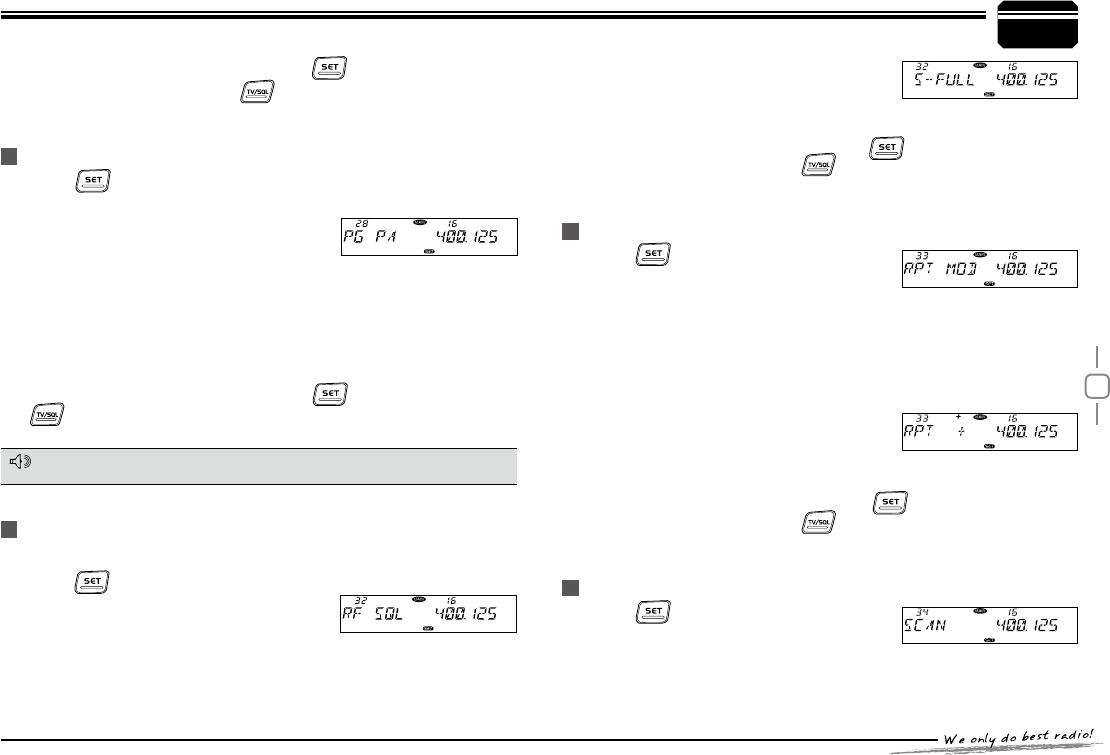
25
Press
1. key to enter function menu.
Turn the Main band selector knob to choose No 28-31 menu. The
2.
LCD displays "PG PA" PG PB, PG PC,
PG PD.
Press the Main band selector knob to enter function setup.
3.
Switch the Main band selector knob to choose wanted value.
4.
TX: When the Main band is transmitting, the sub band receiving will mute.
RX: When the Main band is receiving, the sub band receiving will mute.
RX/TX: the sub band receiving always mute.
Press the Main band selector knob or
5. key to store value and
back to function menu. Press key or hold selector knob for over
0.5 second to store setup and exit.
MICROPHONE PA,PB, PC,PD KEY SETUP
For Menu details, please refer to Page 30-31, Microphone Operation.
NOTE
7
General Setting
Press
1. key to enter function menu.
Turn the Main band selector knob to
2.
Press
1. key to enter function menu.
Turn the Main band selector knob to
2.
choose No34 menu. The LCD displays "SCAN"
Press the Main band selector knob to enter function setup.
3.
Switch the Main band selector knob to choose wanted value.
4.
RF SQUELCH LEVEL SETUP
OFFSET DIRECTION SETUP
SCAN DWELL TIME SETUP
When squelch level function is on, you can cancel squelch only when
the signal strength reach the level setup by users.
Press
1. key to enter function menu.
Turn the Main band selector knob to
2.
choose No32 menu. The LCD displays
"RF SQL"
Press the Main band selector knob to enter function setup.
3.
Switch the Main band selector knob to choose wanted value.
4.
S-2: Able to hear the calling when the power meter reach 1 bar.
choose No33 menu. The LCD displays "RPT MOD"
Press the Main band selector knob to enter function setup.
3.
Switch the Main band selector knob to choose wanted Offset direction.
4.
-: Minus offset, means transmitting frequency lower than receiving
frequency.
+: Plus offset, means transmitting
frequency higher than receiving frequency.
OFF: OFFSET is turn off. Transmitting frequency is same as receiving
frequency.
Press the Main band selector knob or
5. key to store value and
back to function menu. Press key or hold selector knob for over
0.5 second to store setup and exit.
Press the Main band selector knob or
5. key to store value and
back to function menu. Press key or hold selector knob for over
0.5 second to sore setup and exit.
S-5: Able to hear the calling when the
power meter reach 4 bar.
S-9: Able to hear the calling when the power meter reach 8 bar.
S-FULL: Able to hear the calling when the power meter reach full bar.
Press the Main band selector knob or
5. key to store value and
back to function menu. Press key or hold selector knob for over
0.5 second to store setup and exit.
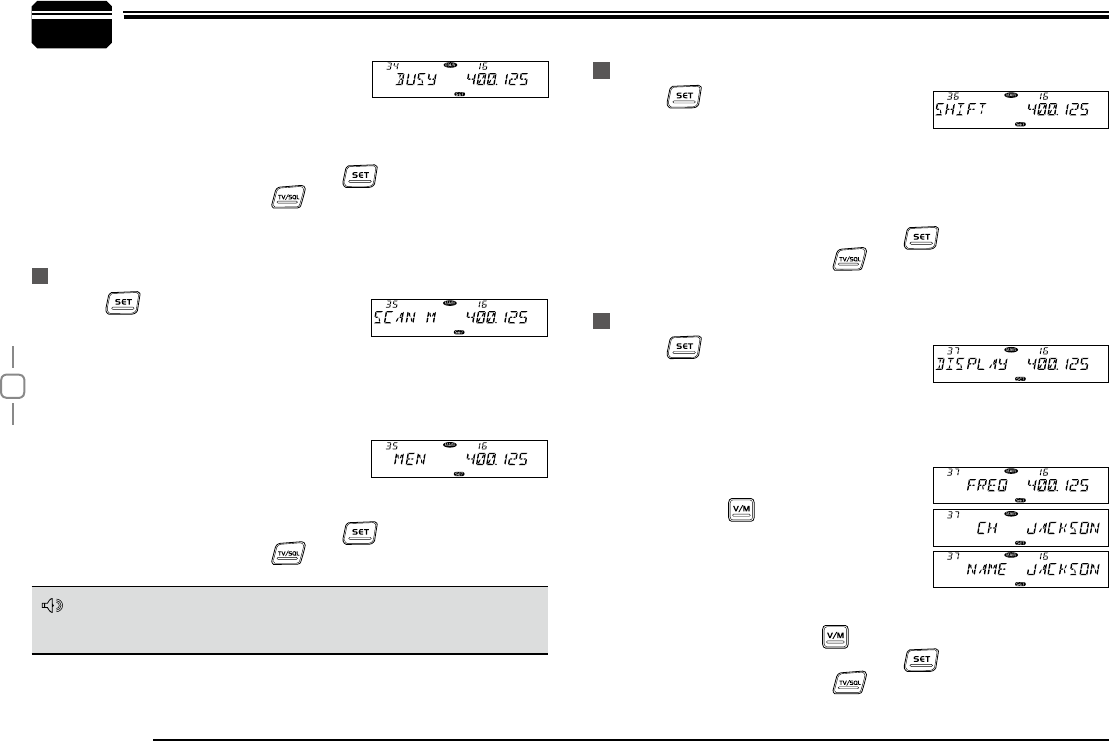
26
5888UV
7General Setting
Press
1. key to enter function menu.
Turn the Main band selector knob to
2.
choose No36 menu. The LCD displays "SHIFT"
Press the Main band selector knob to enter function setup.
3.
Switch the Main band selector knob to choose wanted value.
4.
Available Offset frequency for this transceiver is 0-100MHz.
Press the Main band selector knob or
5. key to store value and
back to function menu. Press key or hold selector knob for over
0.5 second to store setup and exit.
Press
1. key to enter function menu.
Turn the Main band selector knob to
2.
choose No37 menu. The LCD displays "DISPLAY"
Press the Main band selector knob to enter function setup.
3.
Switch the Main band selector knob to choose wanted value.
4.
FREQ: The radio displays channel number
+ frequency in channel mode, if
press key,it will change to
VFO mode.
CH: Displays only channel number.
NAME: In channel mode, It displays the
cha nnel number and channel name if the current channel is
programmed with a name. Otherwise, it display the channel number
and frequency.If press key, it will change to VFO mode.
Press the Main band selector knob or
5. key to store value and
back to function menu. Press key or hold selector knob for over
0.5 second to store setup and exit.
OFFSET FREQUENCY SETUP
DISPLAY MODE SETUP
Before using Priority channel scan function.the edited channel shall be
programmed as P SCAN or refer to the PRI instrunction in page 29 to add
or delete priority channel.
NOTE
Press
1. key to enter function menu.
Turn the Main band selector knob to
2.
choose No35 menu. The LCD displays "SCAN M"
Press the Main band selector knob to enter function setup.
3.
Switch the Main band selector knob to choose wanted value.
4.
MEN: Channel Scan, the transceiver will scan all the channel after
enter channel scan.
MSN: Priority Channel Scan, the
transceiver will only scan the priority channel after enter channel
scan.
Press the Main band selector knob or
5. key to store value and
back to function menu. Press key or hold selector knob for over
0.5 second to store setup and exit.
PRIORITY CHANNEL SCAN
TIME: it pauses 5s once scanning a
matching signal, then resume scan.
BUSY: it pauses once scanning a matching signal, then resume scan
after the signal disappeared for 2 seconds.
SECEDE: It Stops once scanning a matching signal, and exit scan.
Press the Main band selector knob or
5. key to store value and
back to function menu. Press key or hold selector knob for over
0.5 second to store setup and exit.
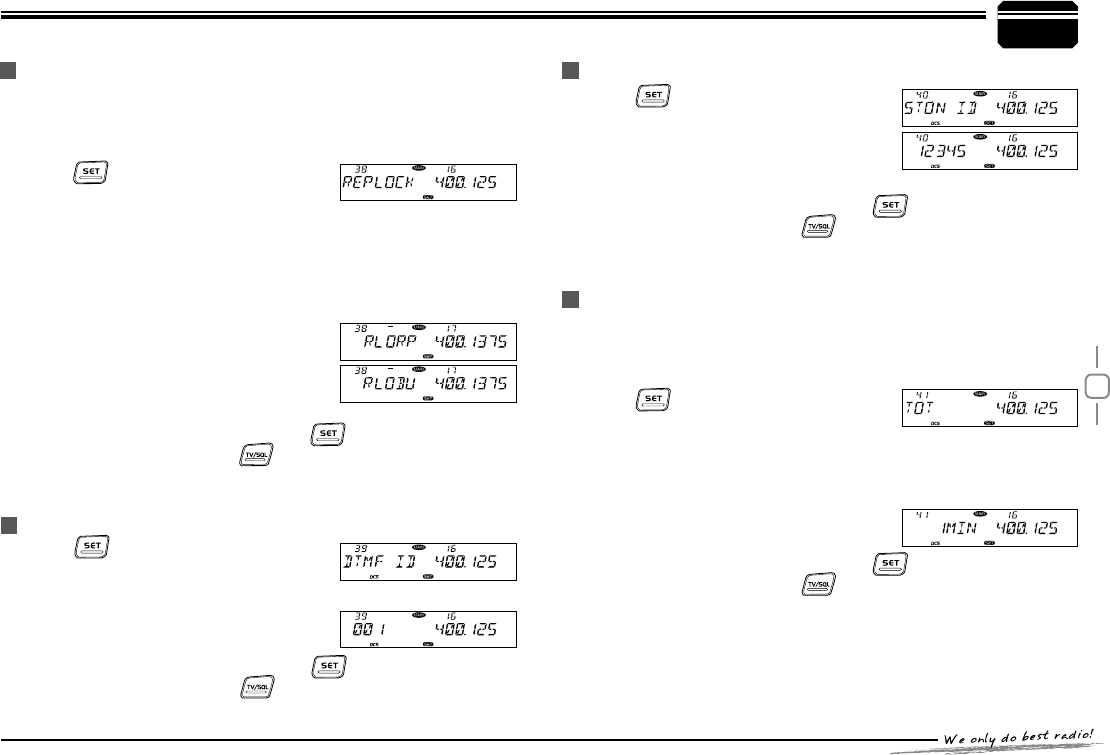
27
With this function on, the transceiver will not transmitting on a busy
channel, to avoid disturbing other transceiver using same frequency.
Once the channel is busy and you press PTT, the transceiver will beep as
warning and return to receiving.
Press
1. key to enter function menu.
Turn the Main band selector knob to
2.
choose No38 menu. The LCD displays "REPLOCK"
Press the Main band selector knob to enter function setup.
3.
Switch the Main band selector knob to choose wanted value.
4.
RLORP: Signaling busy channel lockout, transmitting is inhibited when
current channel receives a matching carrier but dis-matching
CTCSS/DCS.
RLOBU: Channel busy channel lockout, tran
smitting is inhibited when current
channel receives a matching carrier;
OFF: Busy channel lockout is disabled.
Transmitting is allowed in any receiving status.
Press the Main band selector knob or
5. key to store value and
back to function menu. Press key or hold selector knob for over
0.5 second to store setup and exit.
BUSY CHANNEL LOCKOUT
RADIO'S DTMF SELF ID ENQUIRY
7
General Setting
Press
1. key to enter function menu.
Switch the selector knob to choose No40
2.
function. The LCD displays "5TONE ID"
Press the Main band selector knob to
3.
enter function setup. The LCD will show the DTMF self ID.
Press the Main band selector knob or
4. key to store value and
back to function menu. Press key or hold selector knob for over
0.5 second to store setup and exit.
The time-out timer limits the amount of continuous transmitting time.
When the transmitting reaches the time limit which has been
programmed, the transmission will be cut off and emit warning beep.
Press
1. key to enter function menu.
Turn the Main band selector knob to
2.
choose No41 menu. The LCD displays "TOT"
Press the Main band selector knob to enter function setup.
3.
Switch the Main band selector knob to choose wanted value.
4.
1-30 MIN, total 30 levels,
OFF: TOT is turn off.
Press the Main band selector knob or
5. key to store value and
back to function menu. Press key or hold selector knob for over
0.5 second to store setup and exit.
5TONE SELF ID ENQUIR
TOT (TIME-OUT TIMER)
Press
1. key to enter function menu.
Switch the selector knob to choose No 39
2.
function. The LCD displays "DTMF ID"
Press the Main band selector knob to
3.
enter function setup. The LCD will show
the DTMF self ID.
Press the Main band selector knob or
4. key to store value and
back to function menu. Press key or hold selector knob for over
0.5 second to store setup and exit.
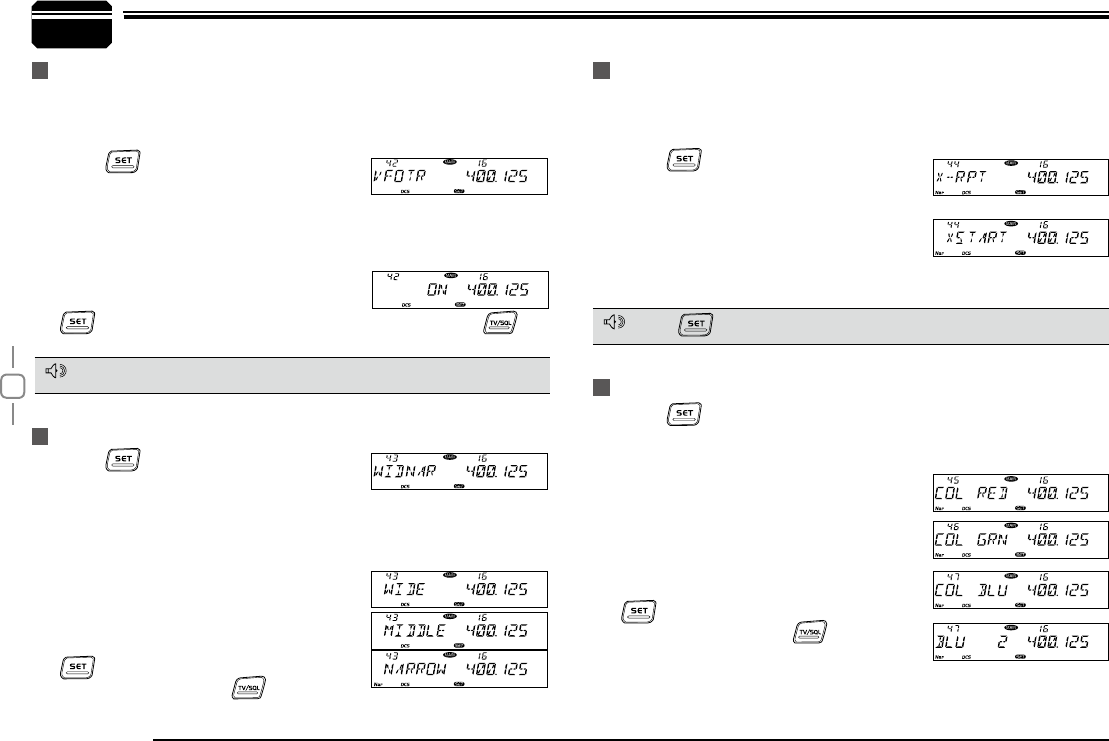
28
5888UV
7General Setting
Set the left band and right band as VHF (136~174MHz) and
UHF(400~470MHz)then turn of this function will enable Cross Band
repeater function.
Press
1. key to enter function menu.
Switch the selector knob to choose No 44
2.
function. The LCD displays "X-RPT"
Press the Main band selector knob, the
3.
LCD displays "XSTART".
Press the Main band selector knob, the radio prompt “DU” and the
4.
LCD displays "RPT", the corss band repeat function is on.
Press
1. key to enter function menu.
Turn the Main band selector knob to choose No. 45-47 menu. The
2.
LCD displays "COL RED","COL GRN","COL BLU"
Press the Main band selector knob to
3.
enter function setup.
Switch the Main band selector knob to
4.
choose wanted value.Each color (Red,
blue, Green) with 32 brightness levels.
Press the Main band selector knob or
5.
key to store value and back to
function menu. Press key or hold
selector knob for over 0.5 second to store
setup and exit.
CROSS BAND REPEAT
LCD BACKLIGHT
Press
1. key to enter function menu.
Turn the Main band selector knob to
2.
choose No43 menu. The LCD displays "WINNAR"
Press the Main band selector knob to enter function setup.
3.
Switch the Main band selector knob to choose wanted value.
4.
WIDE: Wide band (25KHz)
MIDDLE: Middle band (20KHz)
NARROW: Narrow band (12.5KHz)
Press the Main band selector knob or
5.
key to store value and back to
function menu. Press key or hold
selector knob for over 0.5 second to store setup and exit.
WIDE/NARROW BAND
This function only valid when both bands work on VFO mode.
Press will turn off cross band function.
NOTE
NOTE
Enable this function, the adjustment any band of VFO frequency,
will bring same frequency change to both bands. Adjust one gear, the
frequency for both band will increase or decrease one step size value.
Press
1. key to enter function menu.
Turn the Main band selector knob to
2.
choose No42 menu. The LCD displays "VFOTR"
Press the Main band selector knob to enter function setup.
3.
Switch the Main band selector knob to choose wanted value.
4.
Available Values: ON, OFF.
Press the Main band selector knob or
5.
key to store value and back to function menu. Press key
or hold selector knob for over 0.5 second to store setup and exit.
VFO FREQUENCY LINKAGE
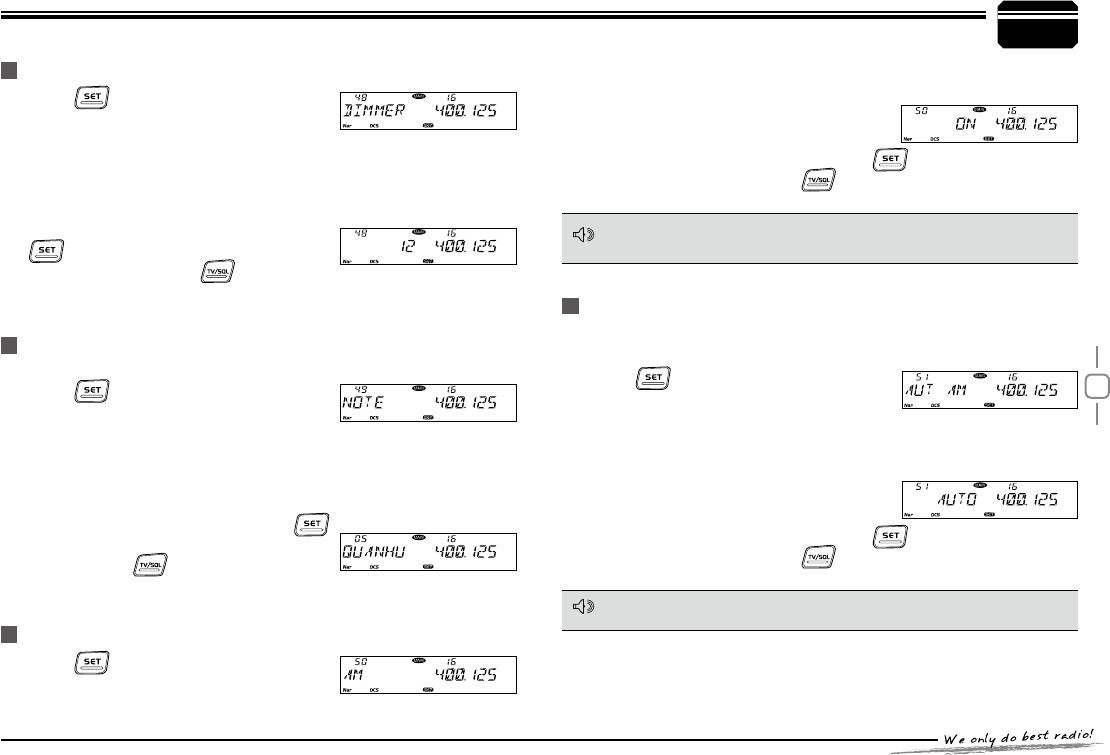
29
Press
1. key to enter function menu.
Turn the Main band selector knob to
2.
choose No. 48 menu. The LCD displays "DIMMER"
Press the Main band selector knob to enter function setup.
3.
Switch the Main band selector knob to choose wanted value.
4.
Available value: 32 brightness levels.
Press the Main band selector knob or
5.
key to store value and back to
function menu. Press key or hold
selector knob for over 0.5 second to store setup and exit.
KEYPAD BACKLIGHT BRIGHTNESS
The transceiver offers enquiry of calling record.
Press
1. key to enter function menu.
Turn the Main band selector knob to
2.
choose No. 49 menu. The LCD displays "NOTE"
Press the Main band selector knob to enter function setup.
3.
Switch the Main band selector knob to choose wanted value.
4.
This transceiver able to record 16 calling at most.
Press the Main band selector knob or
5.
key to store value and back to function
menu. Press key or hold selector
knob for over 0.5 second to store setup and exit.
CALLING RECORD
Press
1. key to enter function menu.
Turn the Main band selector knob to
2.
choose No. 50 menu. The LCD displays "AM"
AM FUNCTION
This function is only valid when the Main band frequency is VHF 118-
174MHz, the function is invalid when the right band is set as Main band.
NOTE
AUTOMATIC AM FUNCTION
To enable Automatic AM function, the AM function shall be turned on rst.
The radio will automatically boot AM function when the VHF frequency
is under 136Mhz
Press
1. key to enter function menu.
Turn the Main band selector knob to
2.
choose No. 51 menu. The LCD displays "AUT AM"
Press the Main band selector knob to enter function setup.
3.
Switch the Main band selector knob to choose wanted value.
4.
ON: turn on auto AM function.
OFF: turn off auto AM function.
Press the Main band selector knob or
5. key to store value and
back to function menu. Press key or hold selector knob for over
0.5 second to store setup and exit.
NOTE
7
General Setting
Press the Main band selector knob to enter function setup.
3.
Switch the Main band selector knob to choose wanted value.
4.
ON: turn on AM function.
OFF: turn off AM function.
Press the Main band selector knob or
5. key to store value and
back to function menu. Press key or hold selector knob for over
0.5 second to store setup and exit.
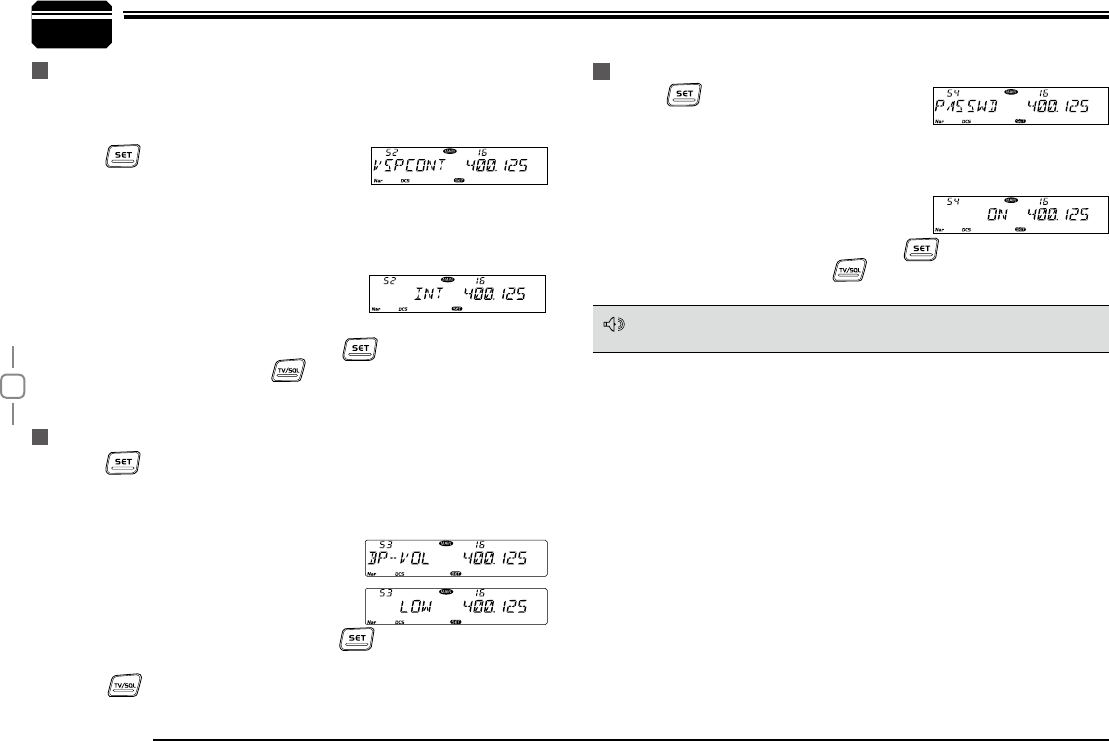
30
5888UV
Press
1. key to enter function menu.
Turn the Main band selector knob to
2.
choose No. 54 menu. The LCD displays "PASSWD"
Press the Main band selector knob to enter function setup.
3.
Switch the Main band selector knob to choose wanted value.
4.
ON: Turn on password function.
OFF: Turn off password function.
Press the Main band selector knob or
5. key to store value and
back to function menu. Press key or hold selector knob for over
0.5 second to store setup and exit.
PASSWORD FUNCTION
When password function is on, correct password shall be input after power
on The password shall be programmed before using this function.
7General Setting
NOTE
BEEP VOLUME CONTROL
Press
1. key to enter function menu.
Turn the Main band selector knob to choose No. 53 menu. The LCD
2.
displays “BP-VOL”
Press the Main band selector knob to enter function setup
3.
Switch the Main band selector knob to
4.
choose wanted value.
LOW: BEEP volume is low.
HIGH: BEEP volume is high.
Press the Main band selector knob or
5. key to store value and
back to function menu.
Press
6. key or hold selector knob for over 0.5 second to store
setup and exit.
VHF EXTERNAL SPEAKER PORT
When the function setup as external (EXT), an external Dual Track
speaker (SP-02) must be connected in order to hear the calling on VHF.
The calling from VHF and UHF are separated in 2 tracks.
Press
1. key to enter function menu.
Turn the Main band selector knob to
2.
choose No. 52 menu. The LCD displays "VSPCONT"
Press the Main band selector knob to enter function setup.
3.
Switch the Main band selector knob to choose wanted value.
4.
INT: Internal speaker, VHF and UHF band share one speaker
EXT: External speaker, the calling on VHF
only audible through the external
Dual Track speaker.
Press the Main band selector knob or
5. key to store value and
back to function menu. Press key or hold selector knob for over
0.5 second to store setup and exit.
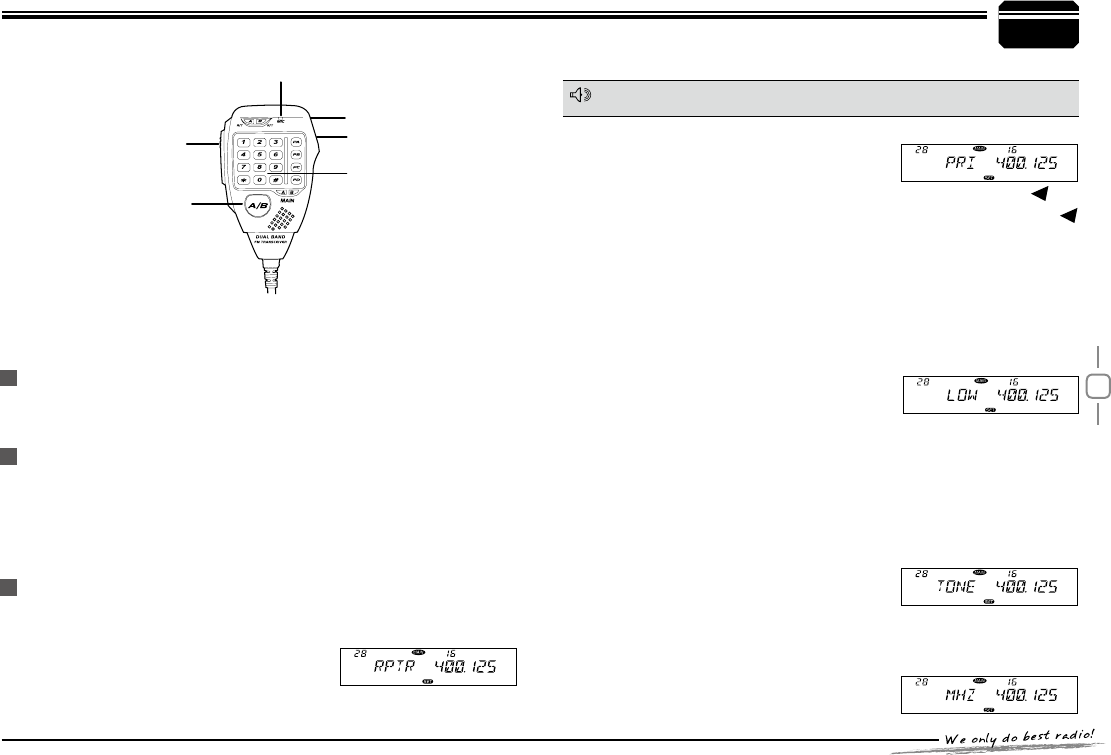
31
8
Microphone Operation
SEND DTMF SIGNALING
MAIN/SUB BAND SWITCHING
FUNCTION OPERATION THROUGH PA-PD KEYS
You can operate the transceiver by keypad or input desired frequency
and channel through the QHM-04 microphone.
Hold the PTT key; input the desired DTMF signaling by the numeric keys.
This transceiver is defaulted on dual receive, in this status, a
MAIN icon will displayed in the top right corner of the Main band
frequency,transmitting only available on the Main band. In standby, you
can switch Main band and sub band by the A/B key.
This function is valid only when current channel set with offset frequency.
PRI:Add or delete priority channel: In
channel mode, press the key programmed
as PRI function to set priority channel, when the LCD displays the
current channel is set as priority channel. repeat above operation, the
disappear, the curent channel is not set as priority channel.
LOW: Output power setup, in standby, press the key programmed as
as LOW function will change the lower level.When LCD displays HIGH,
the transmitting power on current channel is high. When LCD displays
MID1, the transmitting power on current channel is middle1, When LCD
displays MID2, the transmitting power on current channel is middle 2.
When LCD displays LOW, the transmitting
power on current channel is low.
TONE: CTCSS/DCS code setup. In standby, press the key
programmed as TONE function will able to setup CTCSS/DCS code.
when the LCD key to choose CTCSS encode. When the LCD displays
"ENC","DEC" and CTCSS frequency,press the microphone [ UP/DOWN ]
key to choose CTCSS decode. When the LCD displays "DCS" and DCS
code,press microphone displays "ENC" and CTCSS frequency, press the
microphone [ UP/DOWN ] key to choose DCS
code.
MHZ: In VFO mode, press the key programmed as MHZ function,
the megabit digital in the LCD flashes, now turn the channel know or
microphone [ UP/DOWN ] key to adjust
frequency by 1Mhz step. In channel mode,
press this key, the channel number flashes,
The PA,PB,PC,PD, keys are programmable, they can be endowed with
the following functions.
RPTR: OFFSET direction setup, in standby,
press the key programmed as RPTR function
will change the offset direction. when LCD displays"+", means plus offset,
when the LCD displays"-", means minus offset.
NOTE
PTT
Main/Sub band switch
UP
DOWN
MIC
Numeric Keys
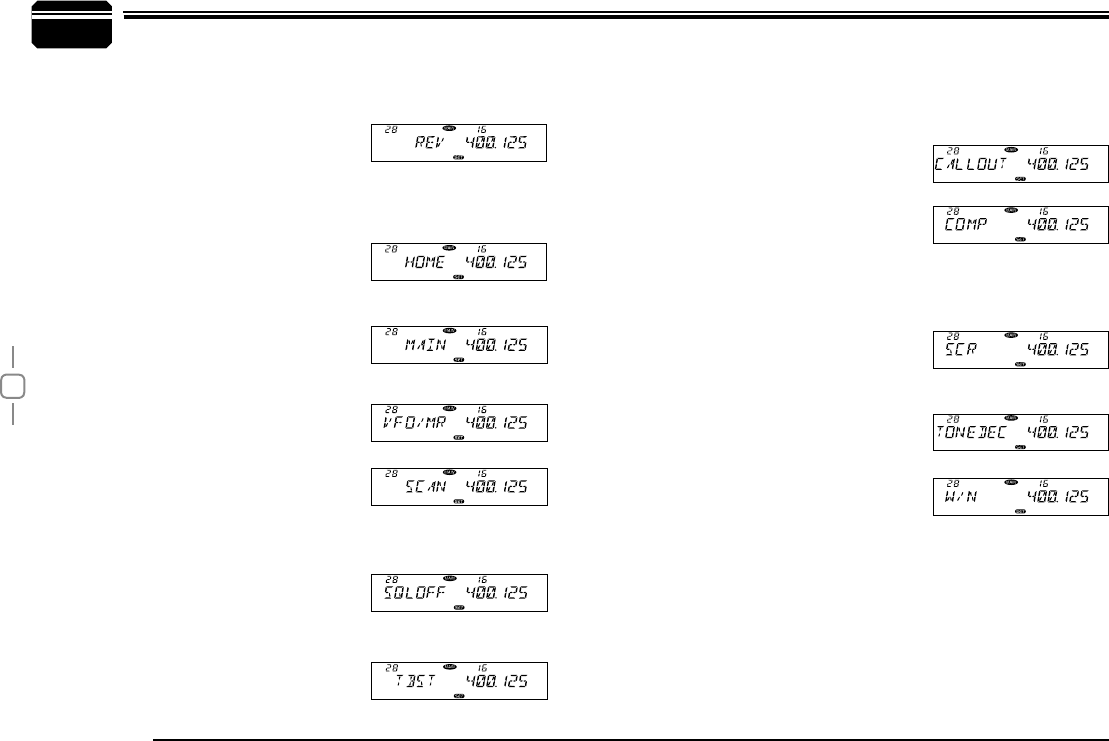
32
5888UV
8Microphone Operation
now adjust selector knob or microphone [ UP/DOWN ] key to adjust
channel.
REV: In standby, press the key programmed
as "REV" function to turnon or turn off Talk
Around function.
HOME: HOME channel switch, in standby press the key programmed
as "HOME" function press the key programmed as HOME function to
switch between HOME channel and current
channel.
MAIN: Main band switch, in standby press the key programmed as
"MAIN" function to cho ose left band or right
band as Main band.
VFO/MR: Working mode switch. in standby, press the key programmed
as "VFO/MR" function to switch between
channel mode and frequency mode.
SCAN: scan function in standby, press the
key programmed as "SCAN" function to start
channel scan or frequency scan.
SQL OFF:Turn off Squelch, in standby, press the key programmed as
"SQL OFF" function to turn off squelch, you
can hear very weak signal, repeat the above
function to turn on squelch.
TBST: Transmit tone burst, in standby;
press the key programmed as "TBST" function
to transmit selected tone burst. This function is use to wake sleeping
repeater.
CALL OUT: Calling, in standby, press the key programmed as "CALL
OUT" function to transmit pre-programmed
DTMF, 2TONE, 5TONE code.
COMP: Compander function in standby ,
press the key programmed as "COMP" to turn
on or turn off Compander function.
SCR: Scrambler function, in standby, press the key programmed as
"SCR" function to turn on or turn off Scrambler function. And choose
optional scrambler groups (from 9 xed groups
and 2 self dened groups).
TONE DEC: Add Optional Signaling, in standby press the key
programmed as"TONE DEC" function to choose
DTMF(DT), 2TONE(2T), 5TONE(5T)or OFF.
W/N: Wide narrow band setup in standby,
press the key programmed as "W/N" function
to choose Wide band, middle and narrow
band.
OFF: No function.
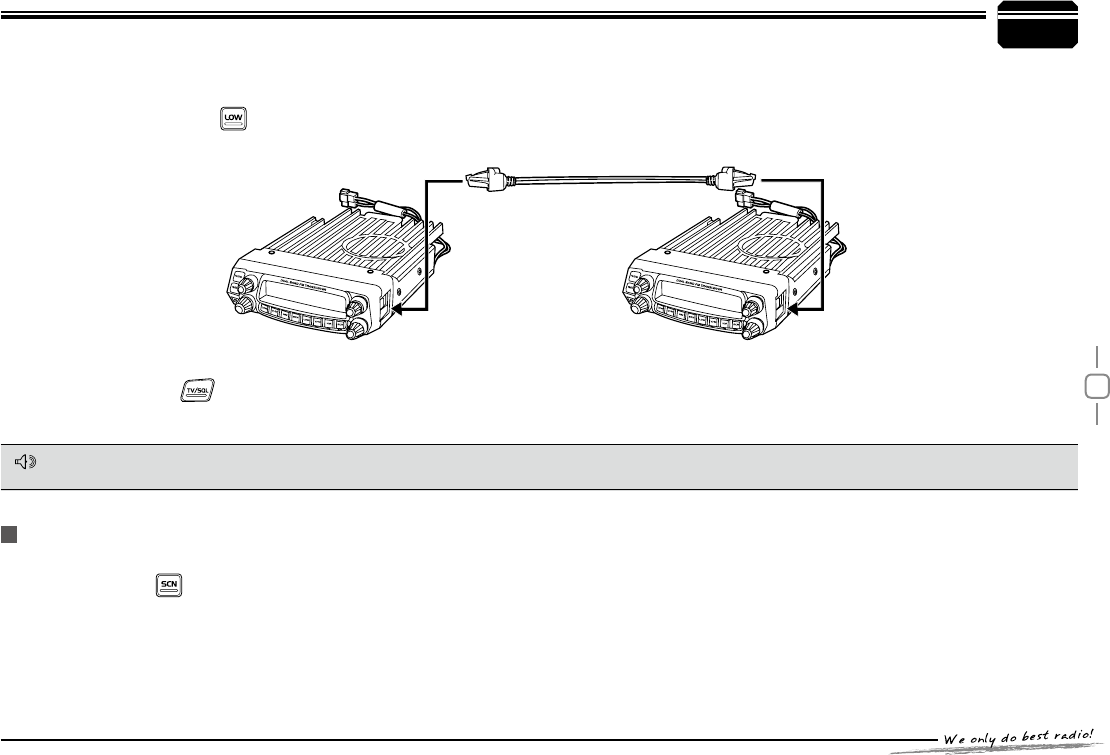
33
Use optional CP51 cloning cable, connect the cable between the data jacks on both master and slave.
1.
Press and hold right band
2. key, then hold this key until the LCD displays "CLONE".
Hold the Main band
3. key. the Master unit and Slave unit both display "CLONE XX", "XX" stands for the data amount being cloned, when the
Master unit displays "CLONE" again, the Slave unit repower on, means the come completed. Turn off the Slave unit, and change another slave
unit. then repeat step 3 to clone next radio.
9Cable Clone
This feature will copy the programmed data and parameters in the master unit to slave units. It copies the parameters and memory program settings.
When the Master unit enter clone mode, repeater step 3 will able to clone multi radios.
If the data is not successfully transmitted, turn off both units, make sure the cable connection is correct and repeat the entire operation from the beginning.
9
Clone Cable (CP-51)
NOTE
RESUME FACTORY DEFAULT
If your radio seems to be malfunctioning becuase of wrong operation or setup, this function will able to resume all setup and channels to factory default.
Hold the right band while power on the radio, all channnel and function setup will resume to factory default.
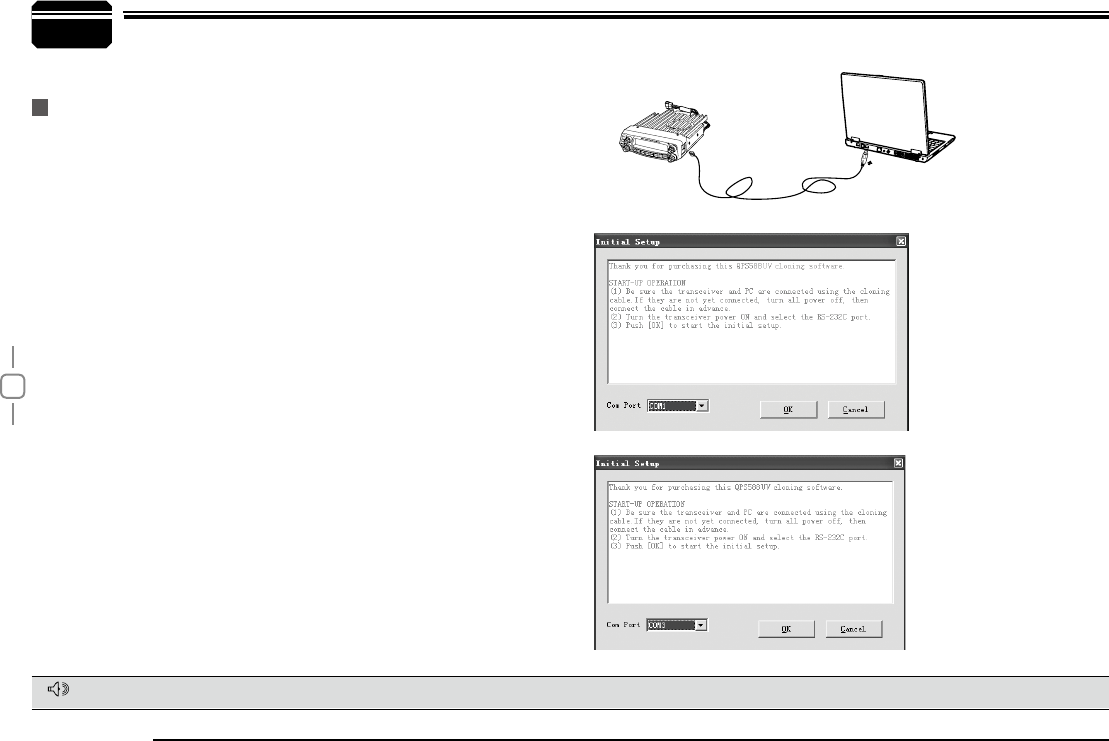
34
5888UV
10
Programming Software Installing and Starting (in windows XP system)
This software has product identify system, so when rstly installing the software, you have to connect the transceiver,otherwise you can not start the software.
Double click ”QPS5888UV setup.exe“, then follow the installing instruction.
INSTALL USB CABLE DRIVER PROGRAMME
Click start menu in computer, under “ALL PROGRAMS” menu,
1.
choose and click “USB To Com port” in QPS5888UV program, install
“USB To Com port” driver by indication.
Connect the optional PC50 USB Programming cable to USB port in
2.
PC with transceiver.(As pic 1)
Double click QPS5888UV shortcut or click QPS5888UV in procedure
3.
index of start menu, choose serial com port as indicated then click
OK to start programming software. (As pic 2)
According to instruction,select correct"COM Port"(As pic 3),then click
4.
"OK" to start programming software.
NOTE: Even in same computer,the selective COM Port is different
when USB cable connects with different USB port.
You shall install software before connecting the USB cable line. Switch
on transceiver before writing frequency.You had better not switch on or
off the power supply of transceiver when it is connected with computer,
otherwise, it will make transceiver unable to read or write frequency. In
this case, you have to turn off programming software, pull out USB cable.
then reinsert USB cable and open software, then rechoose COM Port,
it will turn into normal operation. Therefore, please connect transceiver
with computer after switching on the transceiver. Don't restart transceiver
power when it is connected with computer.
图1
图2
图3
10
NOTE
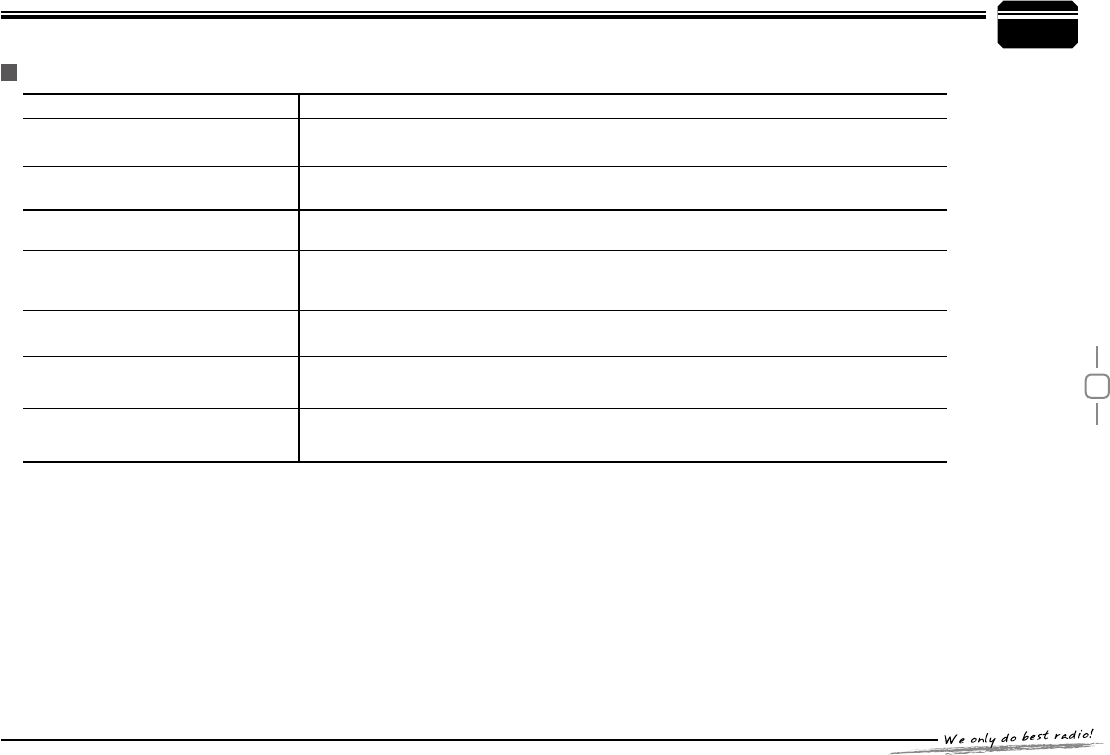
35
Programming Software Installing and Starting (in windows XP system) 11 Maintenance
TROUBLE SHOOTING
Problem Problem Possible Causes and Potential Solutions
(a) Power is on, nothing
appears on Display.
+ and - polarities of power connection are reversed. Connect red lead to plus
terminal and black lead to minus terminal of DC power supply.
(b) Fuse is blown. Check and solve problem resulting in blown fuse and replace fuse with new
fuse.
(c) Display is too dim. Dimmer setting is "LAMP-L". Please make the dimmer setting "LAMP-H".
(d) No sound comes from
speaker.
• Squelch is muted. Decrease squelch level.
• Tone or CTCSS/DCS squelch is active. Turn CTCSS or DCS squelch off.
(e) Key and Dial do not
function. Key-lock function is activated. Cancel Key-lock function.
(f) Rotating Dial will not
change memory channel. Transceiver is in CALL mode. Press the VFO or memory mode.
(g) PTT key is pressed but
transmission does not occur.
• Microphone connection is poor. Connect microphone properly.
• Antenna connection is poor. Connect antenna properly.
11
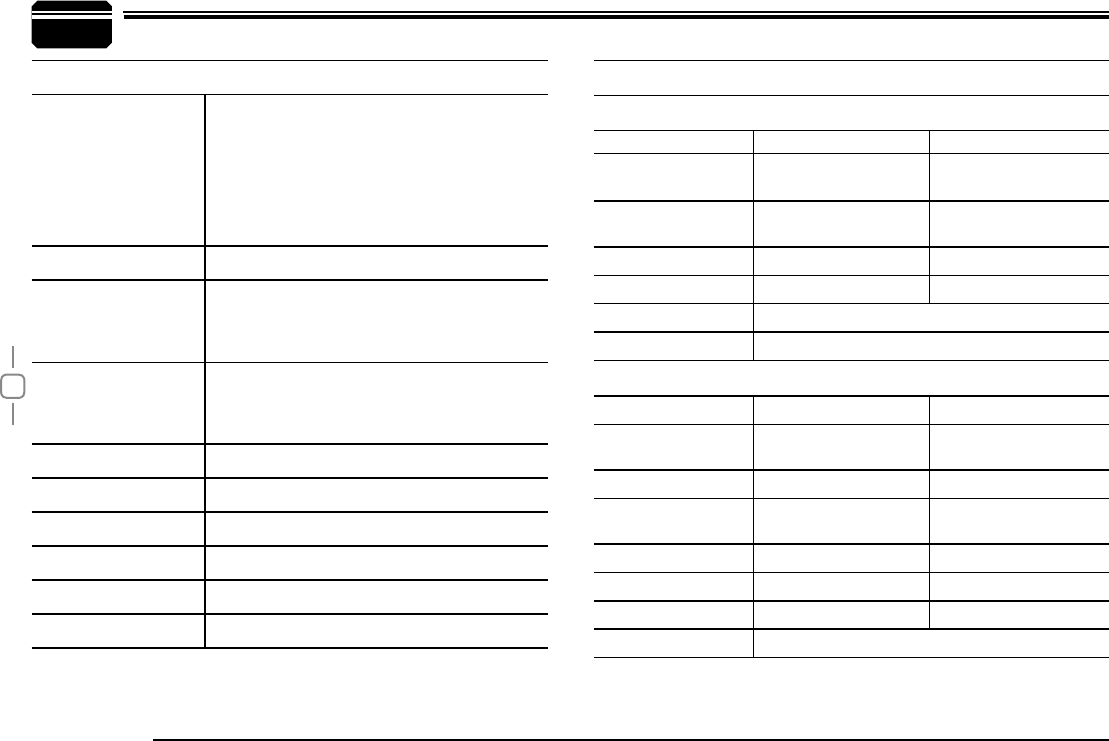
36
5888UV
General
Frequency Range
136~174MHz
400~500MHz
Number of Channels 758 channels
Channel Spacing
12.5KHz(Narrow band)
Phase-locked Step
2.5KHz、5KHz、6.25KHz、10KHz、
12.5KHz、15KHz、20KHz、25KHz、
30KHz、50KHz
Operating Voltage 13.8V DC ±15%
Squelch Carrier/CTCSS/DCS/5Tone/2Tone/DTMF
Frequency Stability ±2.5ppm
Operating Temperature -20~+60℃
Dimensions(WxHxD) 139(W)x40(H)x212(D)mm
Weight about 1.14kg
12
Specifications
RX/TX:136~174MHz,400~520MHz
Receiver (ETSI EN 300 086)
Narrow band
Sensitivity
(12dB SINAD) ≤0.35μV
Adjacent Channel
Selectivity ≥60dB
Audio Response +1~-3dB(0.3~2.55KHz)
Hum & Noise ≥40dB
Audio distortion ≤5%
Audio power output >2W@10%
Transmitter (ETSI EN 300 086)
Narrow band
Power Output 50W (VHF)
40W (UHF)
Modulation 11KΦF3E
Adjacent Channel
Power ≥60dB
Hum & Noise ≥36dB
Spurious Emission ≥70dB
Audio Response +1~-3dB(0.3~2.55KHz)
Audio Distortion ≤5%
12
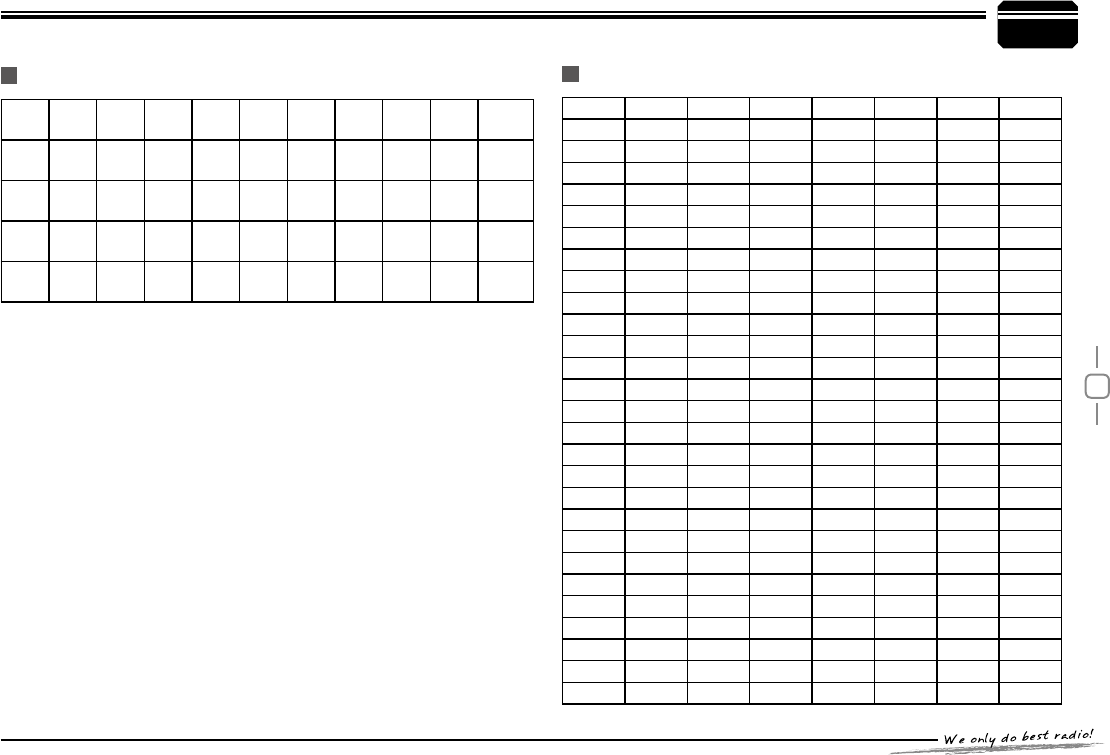
37
13
62.5 77.0 91.5 107.2 127.3 151.4 167.9 183.5 199.5 225.7 254.1
67.0 79.7 94.8 110.9 131.8 156.7 171.3 186.2 203.5 229.1 Self
Dene
69.3 82.5 97.4 114.8 136.5 159.8 173.8 189.9 206.5 233.6
71.9 85.4 100.0 118.8 141.3 162.2 177.3 192.8 210.7 241.8
74.4 88.5 103.5 123.0 146.2 165.5 179.9 196.6 218.1 250.3
51 GROUPS CTCSS TONE FREQUENCY(HZ) 1024 GROUPS DCS CODE
Attached Chart
000 001 002 003 004 005 006 007
010 011 012 013 014 015 016 017
020 021 022 023 024 025 026 027
030 031 032 033 034 035 036 037
040 041 042 043 044 045 046 047
050 051 052 053 054 055 056 057
060 061 062 063 064 065 066 067
070 071 072 073 074 075 076 077
100 101 102 103 104 105 106 107
110 111 112 113 114 115 116 117
120 121 122 123 124 125 126 127
130 131 132 133 134 135 136 137
140 141 142 143 144 145 146 147
150 151 152 153 154 155 156 157
160 161 162 163 164 165 166 167
170 171 172 173 174 175 176 177
200 201 202 203 204 205 206 207
210 211 212 213 214 215 216 217
220 221 222 223 224 225 226 227
230 231 232 233 234 235 236 237
240 241 242 243 244 245 246 247
250 251 252 253 254 255 256 257
260 261 262 263 264 265 266 267
270 271 272 273 274 275 276 277
300 301 302 303 304 305 306 307
310 311 312 313 314 315 316 317
320 321 322 323 324 325 326 327
330 331 332 333 334 335 336 337
13
The self dened CTCSS tone supports non standard codes. The frequency shall be
pre-programmed
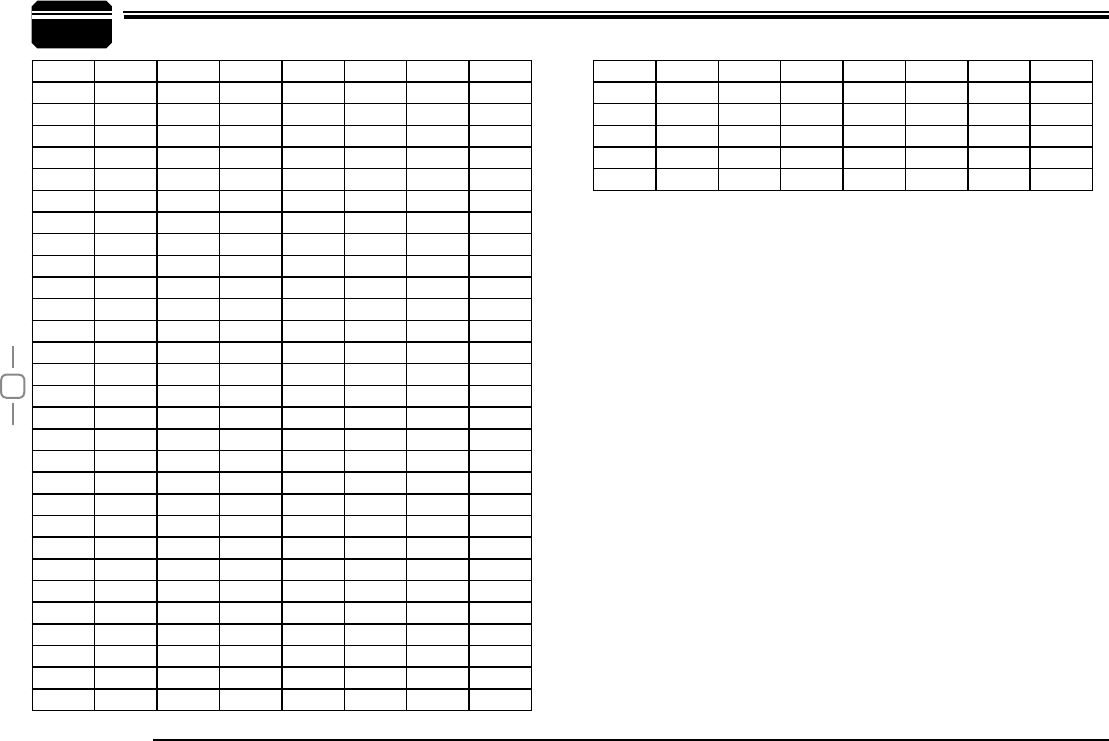
38
5888UV
13
Attached Chart
340 341 342 343 344 345 346 347
350 351 352 353 354 355 356 357
360 361 362 363 364 365 366 367
370 371 372 373 374 375 376 377
400 401 402 403 404 405 406 407
410 411 412 413 414 415 416 417
420 421 422 423 424 425 426 427
430 431 432 433 434 435 436 437
440 441 442 443 444 445 446 447
450 451 452 453 454 455 456 457
460 461 462 463 464 465 466 467
470 471 472 473 474 475 476 477
500 501 502 503 504 505 506 507
510 511 512 513 514 515 516 517
520 521 522 523 524 525 526 527
530 531 532 533 534 535 536 537
540 541 542 543 544 545 546 547
550 551 552 553 554 555 556 557
560 561 562 563 564 565 566 567
570 571 572 573 574 575 576 577
600 601 602 603 604 605 606 607
610 611 612 613 614 615 616 617
620 621 622 623 624 625 626 627
630 631 632 633 634 635 636 637
640 641 642 643 644 645 646 347
650 651 652 653 654 655 656 657
660 661 662 663 664 665 666 667
670 671 672 673 674 675 676 677
700 701 702 703 704 705 706 707
710 711 712 713 714 715 716 717
720 721 722 723 724 725 726 727
730 731 732 733 734 735 736 737
740 741 742 743 744 745 746 747
750 751 752 753 754 755 756 757
760 761 762 763 764 765 766 767
770 771 772 773 774 775 776 777
13

SAFETYTRAININGINFORMATION
YourQixiangElectronScience&TechnologyCo.,LtdradiogeneratesRFelectromagnetic
energyduringtransmitmode.Thisradioisdesignedforandclassifiedas“OccupationalUse
Only”,meaningitmustbeusedonlyduringthecourseofemploymentbyindividualsaware
ofthehazards,andthewaystominimizesuchhazards.ThisradioisNOTintendedforuseby
the“GeneralPopulation”inanuncontrolledenvironment.
ThisradiohasbeentestedandcomplieswiththeFCCRFexposurelimitsfor“OccupationalUseOnly”.Inaddition,
yourQixiangElectronScience&TechnologyCo.,LtdradiocomplieswiththefollowingStandardsandGuidelines
withregardtoRFenergyandelectromagneticenergylevelsandevaluationofsuchlevelsforexposuretohumans:
FCC OET Bulletin 65 Edition 97-01 Supplement C, Evaluating Compliance with FCC Guidelines for Human Exposure to
Radio Frequency Electromagnetic Fields.
American National Standards Institute (C95.1-1992), IEEE Standard for Safety Levels with Respect to Human Exposure
to Radio Frequency Electromagnetic Fields, 3 kHz to 300 GHz.
American National Standards Institute (C95.3-1992), IEEE Recommended Practice for the Measurement of Potentially
Hazardous Electromagnetic Fields– RF and Microwave.
The following accessories are authorized for use with this product. Use of accessories other than those (listed in the
instruction) specified may result in RF exposure levels exceed the FCC requirements for wireless RF exposure.
Theinformationlistedaboveprovidestheuserwiththeinformationneededtomakehimor
herawareofRFexposure,andwhattodotoas‐surethatthisradiooperateswiththeFCCRF
exposurelimitsofthisradio.
ElectromagneticInterference/Compatibility
Duringtransmissions,yourQixiangElectronScience&TechnologyCo.,LtdradiogeneratesRFenergythatcan
possiblycauseinterferencewithotherdevicesorsystems.Toavoidsuchinterference,turnofftheradioinareas
wheresignsarepostedtodoso.DONOToperatethetransmitterinareasthataresensitivetoelectromagnetic
radiationsuchashospitals,aircraft,andblastingsites.
Occupational/ControlledUse
Theradiotransmitterisusedinsituationsinwhichpersonsareexposedasconsequenceoftheiremployment
providedthosepersonsarefullyawareofthepotentialforexposureandcanexercisecontrolovertheirexposure.
InordertocomplywithRFexposurerequirements,aminimumdistanceof200cmmustbemaintainedbetween
theantennaandallpersons

A1.0-12/11